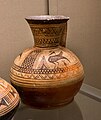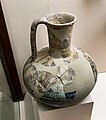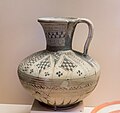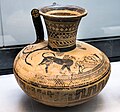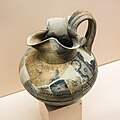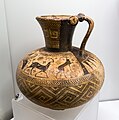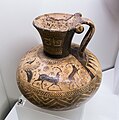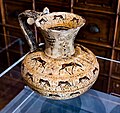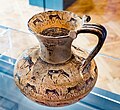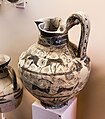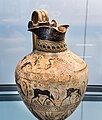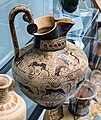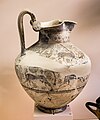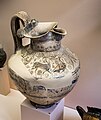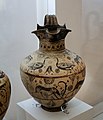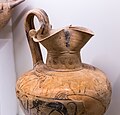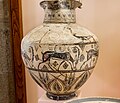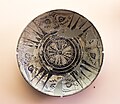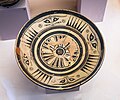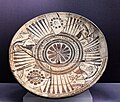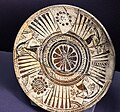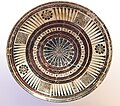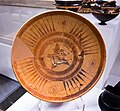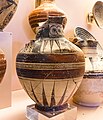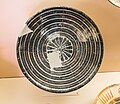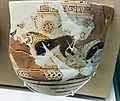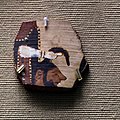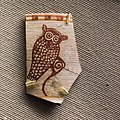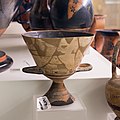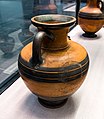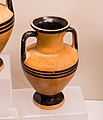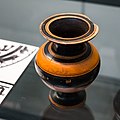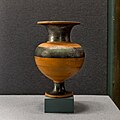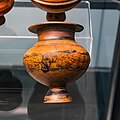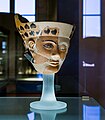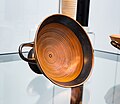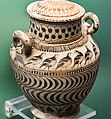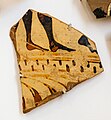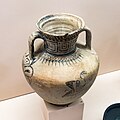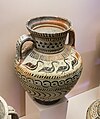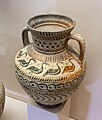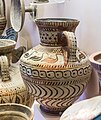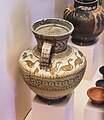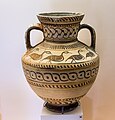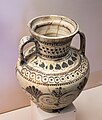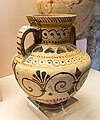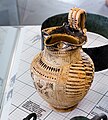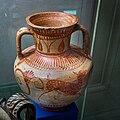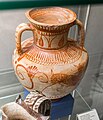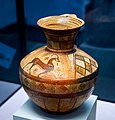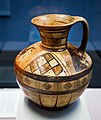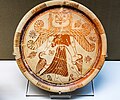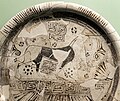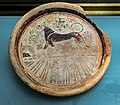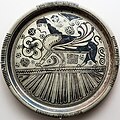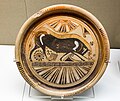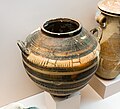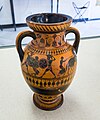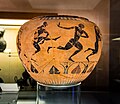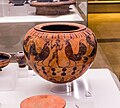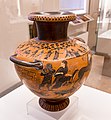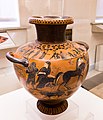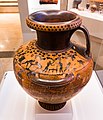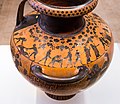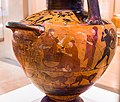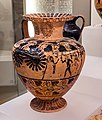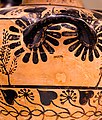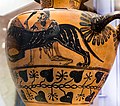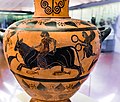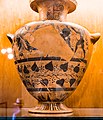User:ArchaiOptix/East Greek painted pottery in the orientalizing and archaic period
Dear visitor,
welcome to this partition of my picture gallery.
For my picture galleries about other object categories of ancient art please turn to my general user page (link on the top of this page).

About me:
I am teaching Classics (Ancient Greek and Latin), Theology, modern Greek and Italian. I am particularly interested in Archaeology and History of Ancient Art. One of my other hobbies is photography. Combining these two hobbies I take lots of pictures in museums and archaeological sites and catalogue the photos according to the scientific literature.
About this picture gallery:
Under the relevant categories (of museums and painting styles) and more systematically on this user page I share a selection of my photos of ancient art.
The site is under construction since January 2020.
I thank all directors of museums who permit photography of the exhibits for private, educational, scientific, non-commercial purposes, thus spreading the knowledge of their treasures in a wider public. I hope that my photos published on wikimedia commons act also as an incentive to visit these museums and admire the works of art directly. Therefore editing the photos I refrain from replacing the background, so that the objects can be seen as displayed in the museum. If you intend to use one of my photos for commercial aims, I would recommend you to contact the museum.
The structure of this picture gallery:
production place (as far as known): regions / islands / towns from north to south
→ artistic epoch (painting style) / object category / date
→→ workshop / class / group / painter
East Greek painted pottery in the orientalizing and archaic period[edit]
There are different attempts to classify the pottery of the eastern Aegean according to chronology and place of production. Most recently and noteworthy:
Robert Manuel Cook, Pierre Dupont, East Greek Pottery, 1998(1) / 2003(2)
Michael Kerschner, Udo Schlotzhauer, A new Classification System for East Greek Pottery, 2005
Aiolis[edit]
important cities, findspots and probable workshop localisations: Methymna, Mytilene, Pitane, Kyme, Larisa, Phokaia
Aiolian grey ware[edit]
Aiolian subgeometric dot style[edit]
classified according to:
Kaan Iren, Aiolische Orientalisierende Keramik, Istanbul 2003
The Wild Goat Style of the Aiolis[edit]
classified according to:
Kaan Iren, Aiolische Orientalisierende Keramik, Istanbul 2003
Group of the London Dinos (Kyme? and / or Larisa?)[edit]
-
Aiolian Wild Goat Style - dinos - Group of the London Dinos - Iren 203 68 - two animal friezes - London BM 1848-0619-1a - 01
-
Aiolian Wild Goat Style - dinos - Group of the London Dinos - Iren 203 68 - two animal friezes - London BM 1848-0619-1a - 02
-
Aiolian Wild Goat Style - dinos - Group of the London Dinos - Iren 203 68 - two animal friezes - London BM 1848-0619-1a - 03
Aiolian late Wild Goat Style[edit]
-
Aiolian Wild Goat Style - plate - protome of goat - München AS 453
Aiolian drop style[edit]
The Wild Goat Style of Northern Ionia[edit]
north ionian archaic Ic / middle wild goat style II(1): 630/625-610 BC[edit]
-
North Ionian Wild Goat Style NiA Ic - oinochoe - two animal friezes - Hamburg MKG AS 1917-988 - 01
-
North Ionian Wild Goat Style NiA Ic - oinochoe - two animal friezes - Hamburg MKG AS 1917-988 - 02
north ionian archaic Id / late wild goat style: 610-590 BC[edit]
-
North Ionian Wild Goat Style NiA Id - oinochoe - griffins - running goats - Rhodos AM 11544 - 01
-
North Ionian Wild Goat Style NiA Id - oinochoe - griffins - running goats - Rhodos AM 11544 - 02
-
North Ionian Wild Goat Style NiA Id - oinochoe - griffins - running goats - Rhodos AM 11544 - 03
-
North Ionian Wild Goat Style NiA Id - oinochoe - griffins - running goats - Rhodos AM 11544 - 04
-
North Ionian Wild Goat Style NiA Id - oinochoe - griffins - running goats - Rhodos AM 11544 - 05
-
North Ionian Wild Goat Style NiA Id - oinochoe - griffins - running goats - Rhodos AM 11544 - 06
-
North Ionian Wild Goat Style NiA Id - oinochoe - griffins - running goats - Rhodos AM 11544 - 07
-
North Ionian Wild Goat Style NiA Id - oinochoe - griffins - running goats - Rhodos AM 11544 - 08
-
North Ionian Wild Goat Style NiA Id - oinochoe - griffins - running goats - Rhodos AM 11544 - 09
-
North Ionian Wild Goat Style NiA Id - neck-amphora - running goat - Wien KHM AS IV - 01
-
North Ionian Wild Goat Style NiA Id - neck-amphora - running goat - Wien KHM AS IV - 02
-
North Ionian Wild Goat Style NiA Id - neck-amphora - running goat - Wien KHM AS IV - 03
-
North Ionian Wild Goat Style NiA Id - neck-amphora - running goat - Wien KHM AS IV - 04
Klazomenian pottery[edit]
Klazomenian Wild Goat Style pottery (reserving technique)[edit]
-
Klazomenian North Ionian Wild Goat Style plate - lotus buds and flowers - Kassel SWhAS T 469 - 01
-
Klazomenian North Ionian Wild Goat Style plate - lotus buds and flowers - Kassel SWhAS T 469 - 02
Klazomenian black figure pottery[edit]
classified according to:
Robert Manuel Cook, A List of Clazomenian Pottery, BSA 47 (1952), 123-152
Tübingen Group[edit]
-
Klazomenian black figure dinos - Tübingen Group - sirens - Cambridge FWM GR-94-6
-
Klazomenian black figure amphora - Tübingen Group - birds - dancing women - Tübingen MUT 2656 - 01
-
Klazomenian black figure amphora - Tübingen Group - birds - dancing women - Tübingen MUT 2656 - 02
-
Klazomenian black figure amphora - Tübingen Group - birds - dancing women - Tübingen MUT 2656 - 03
-
Klazomenian black figure amphora - Tübingen Group - birds - dancing women - Tübingen MUT 2656 - 04
-
Klazomenian black figure lekanis with lid - Tübingen Group - animal friezes - dancing women at altar - München AS 570 - 01
-
Klazomenian black figure lekanis with lid - Tübingen Group - animal friezes - dancing women at altar - München AS 570 - 02
-
Klazomenian black figure lekanis with lid - Tübingen Group - animal friezes - dancing women at altar - München AS 570 - 03
-
Klazomenian black figure lekanis with lid - Tübingen Group - animal friezes - dancing women at altar - München AS 570 - 04
-
Klazomenian black figure lekanis with lid - Tübingen Group - animal friezes - dancing women at altar - München AS 570 - 05
-
Klazomenian black figure lekanis with lid - Tübingen Group - animal friezes - dancing women at altar - München AS 570 - 06
-
Klazomenian black figure lekanis with lid - Tübingen Group - animal friezes - dancing women at altar - München AS 570 - 07
-
Klazomenian black figure lid - Tübingen Group - horsemen and dogs - sirens and sphinxes - Tübingen MUT 1469 - 01
Petrie Group[edit]
-
Klazomenian black figure amphora - Petrie Group - sphinx - four women - London BM 1888-0208-71a - 01
-
Klazomenian black figure amphora - Petrie Group - sphinx - four women - London BM 1888-0208-71a - 02
-
Klazomenian black figure amphora - Petrie Group - sphinx - four women - London BM 1888-0208-71a - 03
Urla Group[edit]
Enmann Class[edit]
Knipovitch Class[edit]
Temrjuk Group
-
Klazomenian black figure neck-amphora - Knipovitch Class - Temrjuk Group - protome of Pegasos - Athens NAM 12713 - 01
-
Klazomenian black figure neck-amphora - Knipovitch Class - Temrjuk Group - protome of Pegasos - Athens NAM 12713 - 02
Klazomenian (?) pottery painted with scale pattern[edit]
-
Klazomenian amphora - scale pattern - Rhodos AM - 01
-
Klazomenian amphora - scale pattern - Rhodos AM - 02
-
Klazomenian amphora - scale pattern - Rhodos AM - 03
-
Klazomenian amphora - scale pattern - Rhodos AM - 04
miscellaneous fragments without attribution to a specific group[edit]
-
Klazomenian black figure dinos - horsemen and fallow deer - Cambridge FWM GR-94-6 - 01
-
Klazomenian black figure dinos - horsemen and fallow deer - Cambridge FWM GR-94-6 - 02
Klazomenian sarcophagi[edit]
classified according to:
Robert Manuel Cook, Clazomenian Sarcophagi, Kerameus 3, Mainz 1981 (with his rather low dating)
precursors of the Albertinum Group[edit]
-
Klazomenian sarcophagus - precursor of the Albertinum Group - hoplite mounting chariot - animals - København NCG 1512B - 01
-
Klazomenian sarcophagus - precursor of the Albertinum Group - hoplite mounting chariot - animals - København NCG 1512B - 02
-
Klazomenian sarcophagus - precursor of the Albertinum Group - hoplite mounting chariot - animals - København NCG 1512B - 03
-
Klazomenian sarcophagus - precursor of the Albertinum Group - hoplite mounting chariot - animals - København NCG 1512B - 04
-
Klazomenian sarcophagus - precursor of the Albertinum Group - hoplite mounting chariot - animals - København NCG 1512B - 05
-
Klazomenian sarcophagus - precursor of the Albertinum Group - hoplite mounting chariot - animals - København NCG 1512B - 06
-
Klazomenian sarcophagus - precursor of the Albertinum Group - hoplite mounting chariot - animals - København NCG 1512B - 07
-
Klazomenian sarcophagus - precursor of the Albertinum Group - hoplite mounting chariot - animals - København NCG 1512B - 08
other sarcophagi of the later sixth century[edit]
-
Klazomenian sarcophagus - later sixth century - sphinxes - München AS 7539 - 01
-
Klazomenian sarcophagus - later sixth century - sphinxes - München AS 7539 - 02
-
Klazomenian sarcophagus - later sixth century - sphinxes - München AS 7539 - 03
-
Klazomenian sarcophagus - later sixth century - sphinxes - München AS 7539 - 04
-
Klazomenian sarcophagus - later sixth century - sphinxes - München AS 7539 - 05
-
Klazomenian sarcophagus - later sixth century - sphinxes - München AS 7539 - 06
-
Klazomenian sarcophagus - later sixth century - sphinxes - München AS 7539 - 07
-
Klazomenian sarcophagus - later sixth century - sphinxes - München AS 7539 - 08
-
Klazomenian sarcophagus - later sixth century - sphinxes - München AS 7539 - 09
-
Klazomenian sarcophagus - later sixth century - sphinxes - München AS 7539 - 10
-
Klazomenian sarcophagus - later sixth century - sphinxes - München AS 7539 - 11
-
Klazomenian sarcophagus - later sixth century - animals - Oxford AM 1911-267 - 01
-
Klazomenian sarcophagus - later sixth century - animals - Oxford AM 1911-267 - 02
Albertinum Group[edit]
-
Klazomenian sarcophagus - Albertinum Group - battle of hoplites - sphinxes - animals - Tübingen MUT 2862 - 01
-
Klazomenian sarcophagus - Albertinum Group - battle of hoplites - sphinxes - animals - Tübingen MUT 2862 - 02
-
Klazomenian sarcophagus - Albertinum Group - battle of hoplites - sphinxes - animals - Tübingen MUT 2862 - 03
-
Klazomenian sarcophagus - Albertinum Group - battle - sphinxes - heads of youths - lion and boar - München AS 8774 - 01
-
Klazomenian sarcophagus - Albertinum Group - battle - sphinxes - heads of youths - lion and boar - München AS 8774 - 02
-
Klazomenian sarcophagus - Albertinum Group - battle - sphinxes - heads of youths - lion and boar - München AS 8774 - 03a
-
Klazomenian sarcophagus - Albertinum Group - battle - sphinxes - heads of youths - lion and boar - München AS 8774 - 03
-
Klazomenian sarcophagus - Albertinum Group - battle - sphinxes - heads of youths - lion and boar - München AS 8774 - 04
-
Klazomenian sarcophagus - Albertinum Group - battle - sphinxes - heads of youths - lion and boar - München AS 8774 - 05
-
Klazomenian sarcophagus - Albertinum Group - battle - sphinxes - heads of youths - lion and boar - München AS 8774 - 06
-
Klazomenian sarcophagus - Albertinum Group - battle - sphinxes - heads of youths - lion and boar - München AS 8774 - 07
-
Klazomenian sarcophagus - Albertinum Group - battle - sphinxes - heads of youths - lion and boar - München AS 8774 - 08
-
Klazomenian sarcophagus - Albertinum Group - battle - sphinxes - heads of youths - lion and boar - München AS 8774 - 09
-
Klazomenian sarcophagus - Albertinum Group - battle - sphinxes - heads of youths - lion and boar - München AS 8774 - 10
-
Klazomenian sarcophagus - Albertinum Group - battle - sphinxes - heads of youths - lion and boar - München AS 8774 - 11
-
Klazomenian sarcophagus - Albertinum Group - battle - sphinxes - heads of youths - lion and boar - München AS 8774 - 12
-
Klazomenian sarcophagus - Albertinum Group - battle - sphinxes - heads of youths - lion and boar - München AS 8774 - 13
-
Klazomenian sarcophagus - Albertinum Group - battle - sphinxes - heads of youths - lion and boar - München AS 8774 - 14
-
Klazomenian sarcophagus - Albertinum Group - battle - sphinxes - heads of youths - lion and boar - München AS 8774 - 15
-
Klazomenian sarcophagus - Albertinum Group - battle - sphinxes - heads of youths - lion and boar - München AS 8774 - 16
-
Klazomenian sarcophagus - Albertinum Group - battle - sphinxes - heads of youths - lion and boar - München AS 8774 - 17
-
Klazomenian sarcophagus - Albertinum Group - battle - sphinxes - heads of youths - lion and boar - München AS 8774 - 18
-
Klazomenian sarcophagus - Albertinum Group - winged goddess with dogs and hoplites - centaurs - animals - Berlin AS 4824 - 01
-
Klazomenian sarcophagus - Albertinum Group - winged goddess with dogs and hoplites - centaurs - animals - Berlin AS 4824 - 02
-
Klazomenian sarcophagus - Albertinum Group - winged goddess with dogs and hoplites - centaurs - animals - Berlin AS 4824 - 03
-
Klazomenian sarcophagus - Albertinum Group - winged goddess with dogs and hoplites - centaurs - animals - Berlin AS 4824 - 04
-
Klazomenian sarcophagus - Albertinum Group - winged goddess with dogs and hoplites - centaurs - animals - Berlin AS 4824 - 05
-
Klazomenian sarcophagus - Albertinum Group - youth leading horse and winged goddess - animals - Tübingen MUT 2253 - 01
-
Klazomenian sarcophagus - Albertinum Group - youth leading horse and winged goddess - animals - Tübingen MUT 2253 - 02
-
Klazomenian sarcophagus - Albertinum Group - youth leading horse and winged goddess - animals - Tübingen MUT 2253 - 03
-
Klazomenian sarcophagus - Albertinum Group - youth leading horse and winged goddess - animals - Tübingen MUT 2253 - 04
-
Klazomenian sarcophagus - Albertinum Group - youth leading horse and winged goddess - animals - Tübingen MUT 2253 - 05
-
Klazomenian sarcophagus - Albertinum Group - youth leading horse and winged goddess - animals - Tübingen MUT 2253 - 06
-
Klazomenian sarcophagus - Albertinum Group - youth leading horse and winged goddess - animals - Tübingen MUT 2253 - 07
-
Klazomenian sarcophagus - Albertinum Group - youth leading horse and winged goddess - animals - Tübingen MUT 2253 - 08
-
Klazomenian sarcophagus - Albertinum Group - goat between lion and panther - København NCG 1512A - 01
-
Klazomenian sarcophagus - Albertinum Group - goat between lion and panther - København NCG 1512A - 02
Hopkinson Painter[edit]
-
Klazomenian sarcophagus - Hopkinson Painter - sphinxes - dogs - head of youth - Rhodos AM 15330 - 01
-
Klazomenian sarcophagus - Hopkinson Painter - sphinxes - dogs - head of youth - Rhodos AM 15330 - 02
-
Klazomenian sarcophagus - Hopkinson Painter - sphinxes - dogs - head of youth - Rhodos AM 15330 - 03
-
Klazomenian sarcophagus - Hopkinson Painter - sphinxes - dogs - head of youth - Rhodos AM 15330 - 04
-
Klazomenian sarcophagus - Hopkinson Painter - sphinxes - dogs - head of youth - Rhodos AM 15330 - 05
The Wild Goat Style of Southern Ionia[edit]
principal production center: Milet (developing into the Fikellura style); in the earlier phases other cities have their share
classified according to:
Robert Manuel Cook, Pierre Dupont, East Greek Pottery, 1998(1) / 2003(2) and
Michael Kerschner, Udo Schlotzhauer, A New Classification System for East Greek Pottery, in: Ancient West and East 4.1, Leiden, Boston 2005
chronology and stylistic criteria differ slightly
rhodian and south ionian early orientalizing / transition from geometric to wild goat style: 680-660/650 BC[edit]
probably local production on Rhodos, gradual transition from rhodian late geometric, flaring shapes, still geometric ornaments and fields with cross-hatching (no concentric circles), but animals (real and mythological) of clear oriental inspiration, drawn in outline and silhouette, rather monumental, mostly set individually in metopes, free compositions more or less symmetrical, some interference between figure drawing and ornament
-
Rhodian early orientalizing style - oinochoe - birds and griffins - Rhodos AM - 01
-
Rhodian early orientalizing style - oinochoe - birds and griffins - Rhodos AM - 02
-
Rhodian early orientalizing style - oinochoe - birds and griffins - Rhodos AM - 03
-
Rhodian early orientalizing style - oinochoe - birds and griffins - Rhodos AM - 04
-
Rhodian early orientalizing style - oinochoe - two male sirens - London BM 1861-0425-48 - 01
-
Rhodian early orientalizing style - oinochoe - two male sirens - London BM 1861-0425-48 - 02
-
Rhodian early orientalizing style - oinochoe - goats and birds - Rhodos AM 12588 - 01
-
Rhodian early orientalizing style - oinochoe - goats and birds - Rhodos AM 12588 - 02
-
Rhodian early orientalizing style - oinochoe - goats and birds - Rhodos AM 12588 - 03
-
Rhodian early orientalizing style - oinochoe - goats and birds - Rhodos AM 12588 - 04
-
Rhodian early orientalizing style - oinochoe - goats and birds - Rhodos AM 12588 - 05
-
Rhodian early orientalizing style - oinochoe - goats and birds - Rhodos AM 12588 - 06
-
Rhodian early orientalizing style - oinochoe - goats and birds - Rhodos AM 12588 - 07
-
Rhodian early orientalizing style - oinochoe - goats and birds - Rhodos AM 12588 - 08
-
Rhodian early orientalizing style - oinochoe - lion - Rhodos AM - 01
-
Rhodian early orientalizing style - oinochoe - lion - Rhodos AM - 02
-
Rhodian early orientalizing style - oinochoe - bull and horse - Rhodos AM - 01
-
Rhodian early orientalizing style - oinochoe - bull and horse - Rhodos AM - 02
-
Rhodian early orientalizing Style - stemmed dish - concentric bands - Rhodos AM
-
Rhodian early orientalizing Style - shallow bowl - three-quarter-circles and wavy lines - Rhodos AM 12061
south ionian archaic Ia / early wild goat style: 660/650-640 BC[edit]
-
South Ionian Wild Goat Style SiA Ia - oinochoe - geometric motives - Rhodos AM - 01
-
South Ionian Wild Goat Style SiA Ia - oinochoe - geometric motives - Rhodos AM - 02
-
South Ionian Wild Goat Style SiA Ia - oinochoe - geometric motives - Rhodos AM - 03
-
South Ionian Wild Goat Style SiA Ia - oinochoe - geometric motives - Rhodos AM - 04
-
South Ionian Wild Goat Style SiA Ia - oinochoe - geometric motives - Rhodos AM - 05
-
South Ionian Wild Goat Style SiA Ia - oinochoe - geometric motives - Rhodos AM - 06
-
South Ionian Wild Goat Style SiA Ia - oinochoe - hare between two lions - München AS - 01
-
South Ionian Wild Goat Style SiA Ia - oinochoe - hare between two lions - München AS - 02
-
South Ionian Wild Goat Style SiA Ia - oinochoe - hare between two lions - München AS - 03
-
South Ionian Wild Goat Style SiA Ia - oinochoe - hare between two lions - München AS - 04
-
South Ionian Wild Goat Style SiA Ia - oinochoe - hare between two lions - München AS - 05
-
South Ionian Wild Goat Style SiA Ia - oinochoe - hare between two lions - München AS - 06
-
South Ionian Wild Goat Style SiA Ia - oinochoe - hare between two lions - München AS - 07
-
South Ionian Wild Goat Style SiA Ia - oinochoe - hare between two lions - München AS - 08
-
South Ionian Wild Goat Style SiA Ia - oinochoe - dogs - Rhodos AM - 01
-
South Ionian Wild Goat Style SiA Ia - oinochoe - dogs - Rhodos AM - 02
-
South Ionian Wild Goat Style SiA Ia - oinochoe - dogs - Rhodos AM - 03
-
South Ionian Wild Goat Style SiA Ia - oinochoe - dogs - Rhodos AM - 04
-
South Ionian Wild Goat Style SiA Ia - oinochoe - dogs - Rhodos AM - 05
-
South Ionian Wild Goat Style SiA Ia - oinochoe - dogs - Rhodos AM - 06
-
South Ionian Wild Goat Style SiA Ia - oinochoe - dogs - Rhodos AM - 07
south ionian archaic Ib / middle wild goat style I: 640-630/625 BC[edit]
-
South Ionian Wild Goat Style SiA Ib - oinochoe - three animal friezes - Berlin AS F 295 - 01
-
South Ionian Wild Goat Style SiA Ib - oinochoe - three animal friezes - Berlin AS F 295 - 02
-
South Ionian Wild Goat Style SiA Ib - oinochoe - three animal friezes - Berlin AS F 295 - 03
-
South Ionian Wild Goat Style SiA Ib - oinochoe - three animal friezes - Berlin AS F 295 - 04
-
South Ionian Wild Goat Style SiA Ib - oinochoe - three animal friezes - Berlin AS F 295 - 05
-
South Ionian Wild Goat Style SiA Ib - oinochoe - three animal friezes - Berlin AS F 295 - 06
-
South Ionian Wild Goat Style SiA Ib - oinochoe - three animal friezes - Berlin AS F 295 - 07
-
South Ionian Wild Goat Style SiA Ib - oinochoe - three animal friezes - Berlin AS F 295 - 08
-
South Ionian Wild Goat Style SiA Ib - oinochoe - three animal friezes - Berlin AS F 295 - 09
-
South Ionian Wild Goat Style SiA Ib - oinochoe - three animal friezes - Berlin AS F 295 - 10
-
South Ionian Wild Goat Style SiA Ib - oinochoe - three animal friezes - Berlin AS F 295 - 11
-
South Ionian Wild Goat Style SiA Ib - oinochoe - three animal friezes - Berlin AS F 295 - 12
-
South Ionian Wild Goat Style SiA Ib - oinochoe - three animal friezes - Berlin AS F 295 - 13
-
South Ionian Wild Goat Style SiA Ib - oinochoe - goats and griffins - Roma MNEVG - 01
-
South Ionian Wild Goat Style SiA Ib - oinochoe - goats and griffins - Roma MNEVG - 02
-
South Ionian Wild Goat Style SiA Ib - oinochoe - goats and griffins - Roma MNEVG - 03
-
South Ionian Wild Goat Style SiA Ib - oinochoe - goats and griffins - Roma MNEVG - 04
-
South Ionian Wild Goat Style SiA Ib - oinochoe - goats and griffins - Roma MNEVG - 05
-
South Ionian Wild Goat Style SiA Ib - oinochoe - goats and griffins - Roma MNEVG - 06
-
South Ionian Wild Goat Style SiA Ib - oinochoe - goats and griffins - Roma MNEVG - 07
-
South Ionian Wild Goat Style SiA Ib - oinochoe - goats and griffins - Roma MNEVG - 08
-
South Ionian Wild Goat Style SiA Ib - oinochoe - goats and griffins - Roma MNEVG - 09
-
South Ionian Wild Goat Style SiA Ib - oinochoe - goats and griffins - Roma MNEVG - 10
-
South Ionian Wild Goat Style SiA Ib - round-mouthed oinochoe - grazing goats - Roma SABAP-RVEm - 01
-
South Ionian Wild Goat Style SiA Ib - round-mouthed oinochoe - grazing goats - Roma SABAP-RVEm - 02
-
South Ionian Wild Goat Style SiA Ib - round-mouthed oinochoe - grazing goats - Roma SABAP-RVEm - 03
-
South Ionian Wild Goat Style SiA Ib - round-mouthed oinochoe - grazing goats - Roma SABAP-RVEm - 04
-
South Ionian Wild Goat Style SiA Ib - round-mouthed oinochoe - grazing goats - Roma SABAP-RVEm - 05
-
South Ionian Wild Goat Style SiA Ib - round-mouthed oinochoe - grazing goats - Roma SABAP-RVEm - 06
-
South Ionian Wild Goat Style SiA Ib - round-mouthed oinochoe - grazing goats - Roma SABAP-RVEm - 07
-
South Ionian Wild Goat Style SiA Ib - round-mouthed oinochoe - grazing goats - Roma SABAP-RVEm - 08
-
South Ionian Wild Goat Style SiA Ib - round-mouthed oinochoe - grazing goats - Roma SABAP-RVEm - 09
-
South Ionian Wild Goat Style SiA Ib - oinochoe - two animal friezes - Herakleion AM 7962
-
South Ionian Wild Goat Style SiA Ib - oinochoe - two animal friezes - Herakleion AM 7962 - 02
-
South Ionian Wild Goat Style SiA Ib - oinochoe - two animal friezes - Herakleion AM
-
South Ionian Wild Goat Style SiA Ib - oinochoe - two animal friezes - Herakleion AM - 02
-
South Ionian Wild Goat Style SiA Ib - oinochoe - dog pursuing goat - Rhodos AM 14023 - 01
-
South Ionian Wild Goat Style SiA Ib - oinochoe - dog pursuing goat - Rhodos AM 14023 - 02
-
South Ionian Wild Goat Style SiA Ib - oinochoe - dog pursuing goat - Rhodos AM 14023 - 03
-
South Ionian Wild Goat Style SiA Ib - oinochoe - dog pursuing goat - Rhodos AM 14023 - 04
-
South Ionian Wild Goat Style SiA Ib - oinochoe - dog pursuing goat - Rhodos AM 14023 - 05
-
South Ionian Wild Goat Style SiA Ib - oinochoe - dog pursuing goat - Rhodos AM 14023 - 06
-
South Ionian Wild Goat Style SiA Ib - oinochoe - dog pursuing goat - Rhodos AM 14023 - 07
south ionian archaic Ic / middle wild goat style II(1): 630/625-610 BC[edit]
-
South Ionian Wild Goat Style SiA Ic - trefoil oinochoe - six animal friezes - Roma SABAP-RVEm - 01
-
South Ionian Wild Goat Style SiA Ic - trefoil oinochoe - six animal friezes - Roma SABAP-RVEm - 02
-
South Ionian Wild Goat Style SiA Ic - trefoil oinochoe - six animal friezes - Roma SABAP-RVEm - 03
-
South Ionian Wild Goat Style SiA Ic - trefoil oinochoe - six animal friezes - Roma SABAP-RVEm - 04
-
South Ionian Wild Goat Style SiA Ic - trefoil oinochoe - six animal friezes - Roma SABAP-RVEm - 05
-
South Ionian Wild Goat Style SiA Ic - trefoil oinochoe - six animal friezes - Roma SABAP-RVEm - 06
-
South Ionian Wild Goat Style SiA Ic - trefoil oinochoe - six animal friezes - Roma SABAP-RVEm - 07
-
South Ionian Wild Goat Style SiA Ic - trefoil oinochoe - six animal friezes - Roma SABAP-RVEm - 08
-
South Ionian Wild Goat Style SiA Ic - trefoil oinochoe - six animal friezes - Roma SABAP-RVEm - 09
-
South Ionian Wild Goat Style SiA Ic - trefoil oinochoe - six animal friezes - Roma SABAP-RVEm - 10
-
South Ionian Wild Goat Style SiA Ic - trefoil oinochoe - six animal friezes - Roma SABAP-RVEm - 11
-
South Ionian Wild Goat Style SiA Ic - trefoil oinochoe - six animal friezes - Roma SABAP-RVEm - 12
-
South Ionian Wild Goat Style SiA Ic - trefoil oinochoe - six animal friezes - Roma SABAP-RVEm - 13
-
South Ionian Wild Goat Style SiA Ic - oinochoe - two animal friezes - Rhodos AM - 01
-
South Ionian Wild Goat Style SiA Ic - oinochoe - two animal friezes - Rhodos AM - 02
-
South Ionian Wild Goat Style SiA Ic - oinochoe - two animal friezes - Rhodos AM - 03
-
South Ionian Wild Goat Style SiA Ic - oinochoe - two animal friezes - Rhodos AM - 04
-
South Ionian Wild Goat Style SiA Ic - oinochoe - two animal friezes - Rhodos AM - 05
-
South Ionian Wild Goat Style SiA Ic - oinochoe - two animal friezes - Rhodos AM - 06
-
South Ionian Wild Goat Style SiA Ic - oinochoe - two animal friezes - Rhodos AM - 07
-
South Ionian Wild Goat Style SiA Ic - oinochoe - three animal friezes - Tübingen MUT 1237 - 01
-
South Ionian Wild Goat Style SiA Ic - oinochoe - three animal friezes - Tübingen MUT 1237 - 02
-
South Ionian Wild Goat Style SiA Ic - oinochoe - three animal friezes - Tübingen MUT 1237 - 03
-
South Ionian Wild Goat Style SiA Ic - oinochoe - three animal friezes - Tübingen MUT 1237 - 04
-
South Ionian Wild Goat Style SiA Ic - oinochoe - three animal friezes - Tübingen MUT 1237 - 05
-
South Ionian Wild Goat Style SiA Ic - oinochoe - two animal friezes - Wien KHM AS IV 1622 - 01
-
South Ionian Wild Goat Style SiA Ic - oinochoe - two animal friezes - Wien KHM AS IV 1622 - 02
-
South Ionian Wild Goat Style SiA Ic - oinochoe - two animal friezes - Wien KHM AS IV 1622 - 03
-
South Ionian Wild Goat Style SiA Ic - oinochoe - two animal friezes - Wien KHM AS IV 1622 - 04
-
South Ionian Wild Goat Style SiA Ic - oinochoe - two animal friezes - Wien KHM AS IV 1622 - 05
-
South Ionian Wild Goat Style SiA Ic - oinochoe - two animal friezes - Wien KHM AS IV 1622 - 06
-
South Ionian Wild Goat Style SiA Ic - oinochoe - two animal friezes - Wien KHM AS IV 1622 - 07
-
South Ionian Wild Goat Style SiA Ic - oinochoe - two animal friezes - Wien KHM AS IV 1622 - 08
-
South Ionian Wild Goat Style SiA Ic - oinochoe - two animal friezes - Wien KHM AS IV 1622 - 09
-
South Ionian Wild Goat Style SiA Ic - oinochoe - two animal friezes - Wien KHM AS IV 1622 - 10
-
South Ionian Wild Goat Style SiA Ic - oinochoe - boar between lions between goats - dog chasing goats - Rhodos AM 12065 - 01
-
South Ionian Wild Goat Style SiA Ic - oinochoe - boar between lions between goats - dog chasing goats - Rhodos AM 12065 - 02
-
South Ionian Wild Goat Style SiA Ic - oinochoe - boar between lions between goats - dog chasing goats - Rhodos AM 12065 - 03
-
South Ionian Wild Goat Style SiA Ic - oinochoe - boar between lions between goats - dog chasing goats - Rhodos AM 12065 - 04
-
South Ionian Wild Goat Style SiA Ic - oinochoe - boar between lions between goats - dog chasing goats - Rhodos AM 12065 - 05
-
South Ionian Wild Goat Style SiA Ic - oinochoe - boar between lions between goats - dog chasing goats - Rhodos AM 12065 - 06
-
South Ionian Wild Goat Style SiA Ic - oinochoe - boar between lions between goats - dog chasing goats - Rhodos AM 12065 - 07
-
South Ionian Wild Goat Style SiA Ic - oinochoe - boar between lions between goats - dog chasing goats - Rhodos AM 12065 - 08
-
South Ionian Wild Goat Style SiA Ic - oinochoe - boar between lions between goats - dog chasing goats - Rhodos AM 12065 - 09
-
South Ionian Wild Goat Style SiA Ic - oinochoe - two animal friezes - München AS 449 - 01
-
South Ionian Wild Goat Style SiA Ic - oinochoe - two animal friezes - München AS 449 - 02a
-
South Ionian Wild Goat Style SiA Ic - oinochoe - two animal friezes - München AS 449 - 02
-
South Ionian Wild Goat Style SiA Ic - oinochoe - two animal friezes - München AS 449 - 03
-
South Ionian Wild Goat Style SiA Ic - oinochoe - two animal friezes - München AS 449 - 04
-
South Ionian Wild Goat Style SiA Ic - oinochoe - two animal friezes - München AS 449 - 05
-
South Ionian Wild Goat Style SiA Ic - oinochoe - two animal friezes - München AS 449 - 06
-
South Ionian Wild Goat Style SiA Ic - oinochoe - two animal friezes - München AS 449 - 07
-
South Ionian Wild Goat Style SiA Ic - oinochoe - two animal friezes - München AS 449 - 08
-
South Ionian Wild Goat Style SiA Ic - oinochoe - two animal friezes - München AS 449 - 09
-
South Ionian Wild Goat Style SiA Ic - oinochoe - two animal friezes - München AS 449 - 10
-
South Ionian Wild Goat Style SiA Ic - oinochoe - geese with goats and deer - Rhodos AM - 01
-
South Ionian Wild Goat Style SiA Ic - oinochoe - geese with goats and deer - Rhodos AM - 02
-
South Ionian Wild Goat Style SiA Ic - oinochoe - geese with goats and deer - Rhodos AM - 03
-
South Ionian Wild Goat Style SiA Ic - oinochoe - geese with goats and deer - Rhodos AM - 04
-
South Ionian Wild Goat Style SiA Ic - oinochoe - geese with goats and deer - Rhodos AM - 05
-
South Ionian Wild Goat Style SiA Ic - oinochoe - geese with goats and deer - Rhodos AM - 06
-
South Ionian Wild Goat Style SiA Ic - oinochoe - geese with goats and deer - Rhodos AM - 07
-
South Ionian Wild Goat Style SiA Ic - oinochoe - geese with goats and deer - Rhodos AM - 08
-
South Ionian Wild Goat Style SiA Ic - oinochoe - geese with goats and deer - Rhodos AM - 09
-
South Ionian Wild Goat Style SiA Ic - oinochoe - geese with goats and deer - Rhodos AM - 10
-
South Ionian Wild Goat Style SiA Ic - oinochoe - geese with goats and deer - Rhodos AM - 11
-
South Ionian Wild Goat Style SiA Ic - oinochoe - geese and goats - Basel ASuSL - 01
-
South Ionian Wild Goat Style SiA Ic - oinochoe - geese and goats - Basel ASuSL - 02
-
South Ionian Wild Goat Style SiA Ic - oinochoe - geese and goats - Basel ASuSL - 03
-
South Ionian Wild Goat Style SiA Ic - oinochoe - geese and goats - Basel ASuSL - 04
-
South Ionian Wild Goat Style SiA Ic - oinochoe - two animal friezes - Athens NAM 12717 - 01
-
South Ionian Wild Goat Style SiA Ic - oinochoe - two animal friezes - Athens NAM 12717 - 02
-
South Ionian Wild Goat Style SiA Ic - oinochoe - wild goat - Cambridge FWM GR 94-6
-
South Ionian Wild Goat Style SiA Ic - oinochoe - three animal friezes - Herakleion AM
-
South Ionian Wild Goat Style SiA Ic - oinochoe - three animal friezes - Herakleion AM - 02
-
South Ionian Wild Goat Style SiA Ic - dinos - three animal friezes - Herakleion AM
-
South Ionian Wild Goat Style SiA Ic - dinos - three animal friezes Herakleion AM - 02
-
South Ionian Wild Goat Style SiA Ic - dinos - three animal friezes Herakleion AM - 03
-
South Ionian Wild Goat Style SiA Ic - dinos - three animal friezes Herakleion AM - 04
-
South Ionian Wild Goat Style SiA Ic - dinos - three animal friezes Herakleion AM - 05
-
South Ionian Wild Goat Style SiA Ic - dinos - three animal friezes Herakleion AM - 06
-
South Ionian Wild Goat Style SiA Ic - dinos with holmos - friezes of grazing goats and ducks - Roma SABAP-RVEm - 01
-
South Ionian Wild Goat Style SiA Ic - dinos with holmos - friezes of grazing goats and ducks - Roma SABAP-RVEm - 02
-
South Ionian Wild Goat Style SiA Ic - dinos with holmos - friezes of grazing goats and ducks - Roma SABAP-RVEm - 03
-
South Ionian Wild Goat Style SiA Ic - dinos with holmos - friezes of grazing goats and ducks - Roma SABAP-RVEm - 04
-
South Ionian Wild Goat Style SiA Ic - dinos with holmos - friezes of grazing goats and ducks - Roma SABAP-RVEm - 05
-
South Ionian Wild Goat Style SiA Ic - dinos with holmos - friezes of grazing goats and ducks - Roma SABAP-RVEm - 06
-
South Ionian Wild Goat Style SiA Ic - dinos with holmos - friezes of grazing goats and ducks - Roma SABAP-RVEm - 07
-
South Ionian Wild Goat Style SiA Ic - dinos with holmos - friezes of grazing goats and ducks - Roma SABAP-RVEm - 08
-
South Ionian Wild Goat Style SiA Ic - dinos with holmos - friezes of grazing goats and ducks - Roma SABAP-RVEm - 09
-
South Ionian Wild Goat Style SiA Ic - dinos with holmos - friezes of grazing goats and ducks - Roma SABAP-RVEm - 10
-
South Ionian Wild Goat Style SiA Ic - dinos with holmos - friezes of grazing goats and ducks - Roma SABAP-RVEm - 11
-
South Ionian Wild Goat Style SiA Ic - dinos with holmos - friezes of grazing goats and ducks - Roma SABAP-RVEm - 12
-
South Ionian Wild Goat Style SiA Ic - dinos with holmos - friezes of grazing goats and ducks - Roma SABAP-RVEm - 13
-
South Ionian Wild Goat Style SiA Ic - dinos with holmos - friezes of grazing goats and ducks - Roma SABAP-RVEm - 14
-
South Ionian Wild Goat Style SiA Ic - stemmed dish - grazing goats - Roma MNEVG Kirch 462 - 01
-
South Ionian Wild Goat Style SiA Ic - stemmed dish - grazing goats - Roma MNEVG Kirch 462 - 02
-
South Ionian Wild Goat Style SiA Ic - stemmed dish - grazing goats - Roma MNEVG Kirch 462 - 03
-
South Ionian Wild Goat Style SiA Ic - stemmed dish - grazing goats - Roma MNEVG Kirch 462 - 04
-
South Ionian Wild Goat Style SiA Ic - stemmed dish - grazing goats - Roma MNEVG Kirch 462 - 05
-
South Ionian Wild Goat Style SiA Ic - stemmed dish - grazing goats - Roma MNEVG Kirch 462 - 06
-
South Ionian Wild Goat Style SiA Ic - stemmed dish - grazing goats - Roma MNEVG Kirch 462 - 07
-
South Ionian Wild Goat Style SiA Ic - stemmed dish - grazing goats - Roma MNEVG Kirch 462 - 08
-
South Ionian Wild Goat Style SiA Ic - stemmed dish - grazing goats - Roma MNEVG Kirch 462 - 09
south ionian archaic Ic-d / middle wild goat style II: 630/625-600 BC: Swallow Painter[edit]
The Swallow Painter (pittore dei rondini) is an east greek south ionian artist who migrated to Etruria and founded a workshop probably at Vulci
-
South Ionian Wild Goat Style SiA Ic - Swallow Painter - oinochoe - grazing goats and goose - Roma MNEVG - 01
-
South Ionian Wild Goat Style SiA Ic - Swallow Painter - oinochoe - grazing goats and goose - Roma MNEVG - 02
-
South Ionian Wild Goat Style SiA Ic - Swallow Painter - oinochoe - grazing goats and goose - Roma MNEVG - 03
-
South Ionian Wild Goat Style SiA Ic - Swallow Painter - oinochoe - grazing goats and goose - Roma MNEVG - 04
-
South Ionian Wild Goat Style SiA Ic - Swallow Painter - oinochoe - grazing goats and goose - Roma MNEVG - 05
-
South Ionian Wild Goat Style SiA Ic - Swallow Painter - oinochoe - grazing goats and goose - Roma MNEVG - 06
-
South Ionian Wild Goat Style SiA Ic - Swallow Painter - oinochoe - grazing goats and goose - Roma MNEVG - 07
-
South Ionian Wild Goat Style SiA Ic - Swallow Painter - krater - men and mythological animals - Roma MNEVG - 01
-
South Ionian Wild Goat Style SiA Ic - Swallow Painter - krater - men and mythological animals - Roma MNEVG - 02
-
South Ionian Wild Goat Style SiA Ic - Swallow Painter - krater - men and mythological animals - Roma MNEVG - 03
-
South Ionian Wild Goat Style SiA Ic - Swallow Painter - krater - men and mythological animals - Roma MNEVG - 04
-
South Ionian Wild Goat Style SiA Ic - Swallow Painter - krater - men and mythological animals - Roma MNEVG - 05
-
South Ionian Wild Goat Style SiA Ic - Swallow Painter - krater - men and mythological animals - Roma MNEVG - 06
-
South Ionian Wild Goat Style SiA Ic - Swallow Painter - krater - men and mythological animals - Roma MNEVG - 07
-
South Ionian Wild Goat Style SiA Ic - Swallow Painter - krater - men and mythological animals - Roma MNEVG - 08
south ionian archaic Id / middle wild goat style II(2)/III: 610-590/580 BC[edit]
-
East Greek Wild Goat Style - oinochoe - lion - Basel ASuSL Bo 76
-
South Ionian Wild Goat Style SiA Id - oinochoe - grazing goats - Rhodos AM - 01
-
South Ionian Wild Goat Style SiA Id - oinochoe - grazing goats - Rhodos AM - 02
-
South Ionian Wild Goat Style SiA Id - oinochoe - grazing goats - Rhodos AM - 03
-
South Ionian Wild Goat Style SiA Id - oinochoe - grazing goats - Rhodos AM - 04
-
South Ionian Wild Goat Style SiA Id - oinochoe - grazing goats - Rhodos AM - 05
-
South Ionian Wild Goat Style SiA Id - oinochoe - grazing goats - Rhodos AM - 06
-
South Ionian Wild Goat Style SiA Id - oinochoe - grazing goats - Rhodos AM - 07
-
South Ionian Wild Goat Style SiA Id - oinochoe - grazing goats - Rhodos AM - 08
-
South Ionian Wild Goat Style SiA Id - oinochoe - grazing goats - Rhodos AM - 09
-
South Ionian Wild Goat Style SiA Id - oinochoe - ornament between geese between sphinxes - goats - Rhodos AM 12067 - 01
-
South Ionian Wild Goat Style SiA Id - oinochoe - ornament between geese between sphinxes - goats - Rhodos AM 12067 - 02
-
South Ionian Wild Goat Style SiA Id - oinochoe - ornament between geese between sphinxes - goats - Rhodos AM 12067 - 03
-
South Ionian Wild Goat Style SiA Id - oinochoe - ornament between geese between sphinxes - goats - Rhodos AM 12067 - 04
-
South Ionian Wild Goat Style SiA Id - oinochoe - ornament between geese between sphinxes - goats - Rhodos AM 12067 - 05
-
South Ionian Wild Goat Style SiA Id - oinochoe - ornament between geese between sphinxes - goats - Rhodos AM 12067 - 06
-
South Ionian Wild Goat Style SiA Id - oinochoe - ornament between geese between sphinxes - goats - Rhodos AM 12067 - 07
-
South Ionian Wild Goat Style SiA Id - oinochoe - ornament between geese between sphinxes - goats - Rhodos AM 12067 - 08
-
South Ionian Wild Goat Style SiA Id - oinochoe - ornament between geese between sphinxes - goats - Rhodos AM 12067 - 09
-
South Ionian Wild Goat Style SiA Id - oinochoe - geese - Rhodos AM 12219 - 01
-
South Ionian Wild Goat Style SiA Id - oinochoe - geese - Rhodos AM 12219 - 02
-
South Ionian Wild Goat Style SiA Id - oinochoe - geese - Rhodos AM 12219 - 03
-
South Ionian Wild Goat Style SiA Id - oinochoe - geese - Rhodos AM 12219 - 04
-
South Ionian Wild Goat Style SiA Id - oinochoe - geese - Rhodos AM 12219 - 05
-
South Ionian Wild Goat Style SiA Id - oinochoe - stag with goose and sphinx - goats - Rhodos AM 13805 - 01
-
South Ionian Wild Goat Style SiA Id - oinochoe - stag with goose and sphinx - goats - Rhodos AM 13805 - 02
-
South Ionian Wild Goat Style SiA Id - oinochoe - stag with goose and sphinx - goats - Rhodos AM 13805 - 03
-
South Ionian Wild Goat Style SiA Id - oinochoe - stag with goose and sphinx - goats - Rhodos AM 13805 - 04
-
South Ionian Wild Goat Style SiA Id - oinochoe - stag with goose and sphinx - goats - Rhodos AM 13805 - 05
-
South Ionian Wild Goat Style SiA Id - oinochoe - stag with goose and sphinx - goats - Rhodos AM 13805 - 06
-
South Ionian Wild Goat Style SiA Id - oinochoe - stag with goose and sphinx - goats - Rhodos AM 13805 - 07
-
South Ionian Wild Goat Style SiA Id - oinochoe - sphinx between geese - goats - Rhodos AM - 01
-
South Ionian Wild Goat Style SiA Id - oinochoe - sphinx between geese - goats - Rhodos AM - 02
-
South Ionian Wild Goat Style SiA Id - oinochoe - sphinx between geese - goats - Rhodos AM - 03
-
South Ionian Wild Goat Style SiA Id - oinochoe - sphinx between geese - goats - Rhodos AM - 04
-
South Ionian Wild Goat Style SiA Id - oinochoe - sphinx between geese - goats - Rhodos AM - 05
-
South Ionian Wild Goat Style SiA Id - oinochoe - sphinx between geese - goats - Rhodos AM - 06
-
South Ionian Wild Goat Style SiA Id - oinochoe - sphinx between geese - goats - Rhodos AM - 07
-
South Ionian Wild Goat Style SiA Id - oinochoe - two animal friezes - Firenze MAN 8003 - 01
-
South Ionian Wild Goat Style SiA Id - oinochoe - two animal friezes - Firenze MAN 8003 - 02
-
South Ionian Wild Goat Style SiA Id - oinochoe - two animal friezes - Firenze MAN 8003 - 03
-
South Ionian Wild Goat Style SiA Id - oinochoe - two animal friezes - Firenze MAN 8003 - 04
-
South Ionian Wild Goat Style SiA Id - oinochoe - two animal friezes - Firenze MAN 8003 - 05
-
South Ionian Wild Goat Style SiA Id - oinochoe - two animal friezes - Firenze MAN 8003 - 06
-
South Ionian Wild Goat Style SiA Id - oinochoe - two animal friezes - Athens NAM - 01
-
South Ionian Wild Goat Style SiA Id - oinochoe - two animal friezes - Athens NAM - 02
-
South Ionian Wild Goat Style SiA Id - oinochoe - two animal friezes - Karlsruhe BL 72-133 - 01
-
South Ionian Wild Goat Style SiA Id - oinochoe - two animal friezes - Karlsruhe BL 72-133 - 02
-
South Ionian Wild Goat Style SiA Id - oinochoe - two animal friezes - Karlsruhe BL 72-133 - 03
-
South Ionian Wild Goat Style SiA Id - oinochoe - two animal friezes - Oxford AM 1966-1021 - 01
-
South Ionian Wild Goat Style SiA Id - oinochoe - two animal friezes - Oxford AM 1966-1021 - 02
-
South Ionian Wild Goat Style SiA Id - oinochoe - two animal friezes - Oxford AM 1966-1021 - 03
-
South Ionian Wild Goat Style SiA Id - oinochoe - two animal friezes - Oxford AM 1966-1021 - 04
-
South Ionian Wild Goat Style SiA Id - oinochoe - goats with stag and goose - Rhodos AM 13806 - 01
-
South Ionian Wild Goat Style SiA Id - oinochoe - goats with stag and goose - Rhodos AM 13806 - 02
-
South Ionian Wild Goat Style SiA Id - oinochoe - goats with stag and goose - Rhodos AM 13806 - 03
-
South Ionian Wild Goat Style SiA Id - oinochoe - goats with stag and goose - Rhodos AM 13806 - 04
-
South Ionian Wild Goat Style SiA Id - oinochoe - animal frieze - München AS - 01
-
South Ionian Wild Goat Style SiA Id - oinochoe - animal frieze - München AS - 02
-
South Ionian Wild Goat Style SiA Id - oinochoe - duck - Rhodos AM 13807 - 01
-
South Ionian Wild Goat Style SiA Id - oinochoe - duck - Rhodos AM 13807 - 02
-
South Ionian Wild Goat Style SiA Id - oinochoe - duck - Rhodos AM 13807 - 03
-
South Ionian Wild Goat Style SiA Id - oinochoe - two confronted geese - London BM
-
South Ionian Wild Goat Style SiA Id - stemmed dish - frontal faces - Rhodos AM 13764
-
South Ionian Wild Goat Style SiA Id - stemmed dish - frontal faces - Rhodos AM 12078 - 01
-
South Ionian Wild Goat Style SiA Id - stemmed dish - frontal faces - Rhodos AM 12078 - 02
-
South Ionian Wild Goat Style SiA Id - stemmed dish - frontal faces - Rhodos AM 12079 - 01
-
South Ionian Wild Goat Style SiA Id - stemmed dish - frontal faces - Rhodos AM 12079 - 02
-
South Ionian Wild Goat Style SiA Id - stemmed dish - frontal faces - Rhodos AM 12079 - 03
-
South Ionian Wild Goat Style SiA Id - stemmed dish - frontal faces - Rhodos AM 12079 - 04
-
South Ionian Wild Goat Style SiA Id - stemmed dish - four geese in metopes - London BM 1860-0404-5
-
South Ionian Wild Goat Style SiA Id - stemmed dish - four geese in metopes - Firenze MAN 80270 - 01
-
South Ionian Wild Goat Style SiA Id - stemmed dish - four geese in metopes - Firenze MAN 80270 - 02
-
South Ionian Wild Goat Style SiA Id - stemmed plate - heads of goat and geese - Basel ASuSL 1906-255
-
South Ionian Wild Goat Style SiA Id - stemmed dish - protomes of wild goats - Wien KHM AS IV 1669 - 01
-
South Ionian Wild Goat Style SiA Id - stemmed dish - protomes of wild goats - Wien KHM AS IV 1669 - 02
-
South Ionian Wild Goat Style SiA Id - stemmed dish - protomes of wild goats - Wien KHM AS IV 1669 - 03
-
South Ionian Wild Goat Style SiA Id - stemmed dish - protomes of wild goats - Wien KHM AS IV 1669 - 04
-
South Ionian Wild Goat Style SiA Id - stemmed dish - floral and geometric decoration - Rhodos AM - 01
-
South Ionian Wild Goat Style SiA Id - stemmed dish - floral and geometric decoration - Rhodos AM - 02
-
South Ionian Wild Goat Style SiA Id - fragments of stemmed dishes - geometric ornaments - Rhodos AM
-
South Ionian Wild Goat Style SiA Id - stemmed dish - floral and geometric decoration - Roma MNEVG - 01
-
South Ionian Wild Goat Style SiA Id - stemmed dish - floral and geometric decoration - Roma MNEVG - 02
-
South Ionian Wild Goat Style SiA Id - stemmed dish - rays and circles and dot rosettes - Rhodos AM 12220 - 01
-
South Ionian Wild Goat Style SiA Id - stemmed dish - rays and circles and dot rosettes - Rhodos AM 12220 - 02
-
South Ionian Wild Goat Style SiA Id - stemmed dish - star with rays and circles and dot rosettes - Rhodos AM 14029 - 01
-
South Ionian Wild Goat Style SiA Id - stemmed dish - star with rays and circles and dot rosettes - Rhodos AM 14029 - 02
-
South Ionian Wild Goat Style SiA Id - stemmed dish - star with rays and circles and dot rosettes - Rhodos AM 14029 - 03
south ionian archaic IIa / middle wild goat style III / late wild goat style: 590/580-560 BC[edit]
-
South Ionian Wild Goat Style SiA IIa - oinochoe - animal frieze - London BM 1865-1214-2 - 01
-
South Ionian Wild Goat Style SiA IIa - oinochoe - animal frieze - London BM 1865-1214-2 - 02
-
South Ionian Wild Goat Style SiA IIa - oinochoe - animal frieze - Firenze MAN 79248- 01
-
South Ionian Wild Goat Style SiA IIa - oinochoe - animal frieze - Firenze MAN 79248- 02
-
South Ionian Wild Goat Style SiA IIa - oinochoe - head of woman and head of man - Rhodos AM 14099 - 01
-
South Ionian Wild Goat Style SiA IIa - oinochoe - head of woman and head of man - Rhodos AM 14099 - 02
-
South Ionian Wild Goat Style SiA IIa - oinochoe - head of woman and head of man - Rhodos AM 14099 - 03
-
South Ionian Wild Goat Style SiA IIa - oinochoe - head of woman and head of man - Rhodos AM 14099 - 04
-
South Ionian Wild Goat Style SiA IIa - oinochoe - head of woman and head of man - Rhodos AM 14099 - 05
-
South Ionian Wild Goat Style SiA IIa - oinochoe - head of woman and head of man - Rhodos AM 14099 - 06
-
South Ionian Wild Goat Style SiA IIa - oinochoe - head of woman and head of man - Rhodos AM 14099 - 07
-
South Ionian Wild Goat Style SiA IIa - oinochoe - head of goat - Rhodos AM - 01
-
South Ionian Wild Goat Style SiA IIa - oinochoe - head of goat - Rhodos AM - 02
-
South Ionian Wild Goat Style SiA IIa - oinochoe - head of goat - Rhodos AM - 03
-
South Ionian Wild Goat Style SiA IIa - oinochoe - head of goat - Rhodos AM - 04
-
South Ionian Wild Goat Style SiA IIa - oinochoe - head of goat - Rhodos AM - 05
-
South Ionian Wild Goat Style SiA IIa - oinochoe - head of goat - Rhodos AM - 06
-
South Ionian Wild Goat Style SiA IIa - oinochoe - head of goat - Rhodos AM - 07
-
South Ionian Wild Goat Style SiA IIa - oinochoe - head of goat - Rhodos AM - 08
-
South Ionian Wild Goat Style SiA IIa - oinochoe fragment - head of goat - Rhodos AM
-
South Ionian Wild Goat Style SiA IIa - stemmed dish - four protomes of wild goats - København NCG 3411- 01
-
South Ionian Wild Goat Style SiA IIa - stemmed dish - four protomes of wild goats - København NCG 3411- 02
-
South Ionian Wild Goat Style SiA IIa - stemmed dish - four protomes of wild goats - København NCG 3411- 03
-
South Ionian Wild Goat Style SiA IIa - stemmed dish - rosette in concentric bands - Rhodos AM 12554
-
South Ionian Wild Goat Style SiA IIa - stemmed dish - rosette and dot row in concentric bands - Rhodos AM 13813
-
South Ionian Wild Goat Style SiA IIa - stemmed dish - windmill pattern and dot rosettes in concentric circles - Rhodos AM 11545 - 01
-
South Ionian Wild Goat Style SiA IIa - stemmed dish - windmill pattern and dot rosettes in concentric circles - Rhodos AM 11545 - 02
-
South Ionian Wild Goat Style SiA IIa - stemmed dish - star in bands and meander - Rhodos AM - 01
-
South Ionian Wild Goat Style SiA IIa - stemmed dish - star in bands and meander - Rhodos AM - 02
-
South Ionian Wild Goat Style SiA IIa - stemmed dish - star in bands and meander - Rhodos AM - 03
-
South Ionian Wild Goat Style SiA IIa - stemmed dish - star in concentric bands and meander - Rhodos AM - 01
-
South Ionian Wild Goat Style SiA IIa - stemmed dish - star in concentric bands and meander - Rhodos AM - 02
-
South Ionian Wild Goat Style SiA IIa - stemmed dish - star with concentric bands and meander - Rhodos AM - 01
-
South Ionian Wild Goat Style SiA IIa - stemmed dish - star with concentric bands and meander - Rhodos AM - 02
-
South Ionian Wild Goat Style SiA IIa - stemmed dish - star with concentric bands and meander - Rhodos AM - 03
-
South Ionian Wild Goat Style SiA IIa - stemmed dish - star in concentric circles - Rhodos AM 12100
-
South Ionian Wild Goat Style SiA IIa - bowl - star and meander - Rhodos AM
The Wild Goat / Animal Style of Chios[edit]
For the sake of terminological coherence all the pottery from Chios of the orientalizing and archaic periods is called ‘wild goat style’, although the wild goats soon disappear from the repertoire of chian painters.
classified according to:
Anna A. Lemos, Archaic Pottery of Chios, Oxford 1991, with additional attributions from other scientists ("Lemos extra")
chian middle wild goat style II: 630/625-600 BC[edit]
Würzburg Chalice Group[edit]
-
Chian Wild Goat Style - chalice - Würzburg Chalice Group - Lemos 236 - animal frieze - Würzburg MvWM L128 - 01
-
Chian Wild Goat Style - chalice - Würzburg Chalice Group - Lemos 236 - animal frieze - Würzburg MvWM L128 - 02
-
Chian Wild Goat Style - chalice - Würzburg Chalice Group - Lemos 236 - animal frieze - Würzburg MvWM L128 - 03
-
Chian Wild Goat Style - chalice - Würzburg Chalice Group - Lemos 236 - animal frieze - Würzburg MvWM L128 - 04
-
Chian Wild Goat Style - chalice - Würzburg Chalice Group - Lemos 236 - animal frieze - Würzburg MvWM L128 - 05
-
Chian Wild Goat Style - chalice - Würzburg Chalice Group - Lemos 236 - animal frieze - Würzburg MvWM L128 - 06
-
Chian Wild Goat Style - chalice - Würzburg Chalice Group - Lemos 237 - animal frieze - Würzburg MvWM Ha 245 - 01.jpg
-
Chian Wild Goat Style - chalice - Würzburg Chalice Group - Lemos 237 - animal frieze - Würzburg MvWM Ha 245 - 02
-
Chian Wild Goat Style - chalice - Würzburg Chalice Group - Lemos 237 - animal frieze - Würzburg MvWM Ha 245 - 03
-
Chian Wild Goat Style - chalice - Würzburg Chalice Group - wild goat - Cambridge FWM GR-63-1894
Group of the Aphrodite Bowl[edit]
-
Chian Wild Goat Style - lekane - Group of the Aphrodite bowl - Lemos 252 - two animal friezes - London BM 1888-0601-456 - 01
-
Chian Wild Goat Style - lekane - Group of the Aphrodite bowl - Lemos 252 - two animal friezes - London BM 1888-0601-456 - 02
chian mature animal style: 610-580 BC[edit]
Group of the Elaborate Animal Chalices[edit]
-
Chian Wild Goat Style - chalice - Group of the Elaborate Animal Chalices - Lemos 546 - animal frieze - London BM 1888-0601-463 - 01
-
Chian Wild Goat Style - chalice - Group of the Elaborate Animal Chalices - Lemos 546 - animal frieze - London BM 1888-0601-463 - 02
-
Chian Wild Goat Style - chalice - Group of the Elaborate Animal Chalices - Lemos 552 - animal frieze - London BM 1924-1201-537
mature animal style chalices without attribution to a specific group[edit]
-
Chian Wild Goat Style - chalice - mature animal style - Lemos extra - lotus flowers and rosettes - London BM 1924-1201-556 and 635
-
Chian Wild Goat Style - chalice - mature animal style - Lemos extra - lion - London BM 1923-1210-10 and 1888-0601-472a
chian grand style: 580-570 BC[edit]
vases with filling ornaments[edit]
-
Chian Wild Goat Style - chalice - grand style - Lemos 701 - bearded man - London BM 1888-0601-482a
-
Chian Wild Goat Style - chalice - grand style - Lemos 703 - bearded man - London BM 1888-0601-482c
Naukratis Painter[edit]
-
Chian Wild Goat Style - chalice - Naukratis Painter - Lemos 727 - bearded man - London BM 1888-0601-501
-
Chian Wild Goat Style - chalice - Naukratis Painter - Lemos 730 - man in chiton and himation - London BM 1888-0601-506
-
Chian Wild Goat Style - chalice - Naukratis Painter - Lemos 733 - woman holding head of a man - London BM 1888-0601-504
-
Chian Wild Goat Style - chalice - Naukratis Painter - Lemos 737 - procession of men - London BM 1888-0601-513
Group of the Naukratis Painter[edit]
-
Chian Wild Goat Style - chalice - Group of the Naukratis Painter - Lemos 726 - bearded man with turban - London BM 1888-0601-503
chian grand style chalices without attribution to a specific group[edit]
-
Chian Wild Goat Style - chalice - grand style - Lemos 711 - owl - London BM 1888-0601-491
-
Chian Wild Goat Style - chalice - grand style - Lemos 728 - padded dancer - London BM 1888-0601-507 and 788
chian chalice / simple animal style: 580-550/540 BC[edit]
chalices with no filling ornaments[edit]
-
Chian Wild Goat Style - chalice - vase with no filling ornament - Lemos 887 - animal frieze - London BM 1888-0601-467
-
Chian Wild Goat Style - chalice - vase with no filling ornament - Lemos 973 - sphinx - Firenze MAN 79244 - 01
-
Chian Wild Goat Style - chalice - vase with no filling ornament - Lemos 973 - sphinx - Firenze MAN 79244 - 02
-
Chian Wild Goat Style - chalice - vase with no filling ornament - Lemos 973 - sphinx - Firenze MAN 79244 - 03
phialai with no filling ornaments[edit]
-
Chian Wild Goat Style - phiale - chalice style - Lemos 981 - woman - London BM 1888-0601-476-h
Group of Worshippers[edit]
-
Chian Wild Goat Style - chalice - Group of Worshippers - Lemos 890 - woman holding pomegranate - London BM 1888-0601-481
early chian black figure: the Sphinx and Lion Style[edit]
Group B[edit]
-
Chian Wild Goat Style - bowl or skyphos krater - black figure sphinx and lion style group B - Lemos 1347 - sphinxes - Oxford AM 1889-215a
chian black figure komast chalices: 560-550 BC[edit]
komast chalices group C[edit]
-
Chian Wild Goat Style - chalice - black figure komast group C - Lemos 1505 and 1506 - two dancing komasts - London BM 1888-0601-548-c and 548-l
komast chalices group F[edit]
-
Chian Wild Goat Style - chalice - black figure komast group F - Lemos 1509 - dancing komast - London BM 1886-0401-1066
other groups of chian black figure chalices: 560-540 BC[edit]
Poultry Group[edit]
-
Chian Wild Goat Style - chalice - black figure Poultry Group - Lemos 1614 - duck or goose - London BM 1867-0506-42
chian pottery without figural decoration[edit]
chian chalices without figural decoration Typ Hayes I: 630-600 BC[edit]
-
Chian Wild Goat Style - chalice - linear decoration - Roma MNEVG - 01
-
Chian Wild Goat Style - chalice - linear decoration - Roma MNEVG - 02
chian chalices without figural decoration: 600-550 BC[edit]
-
Chian Wild Goat Style - chalice - linear decoration - Roma MNEVG 21789 - 01
-
Chian Wild Goat Style - chalice - linear decoration - Roma MNEVG 21789 - 02
chian kantharoi type B: 575-550 BC[edit]
-
Chian Wild Goat Style - kantharos type B - inscription - London BM 1888-0601-165
-
Chian Wild Goat Style - kantharos type B - inscription - London BM 1924-1201-726 and 722
-
Chian Wild Goat Style - kantharos type B - inscription - London BM 1924-1201-755 and 808
-
Chian Wild Goat Style - kantharos type B - inscription - London BM 1924-1201-824
-
Chian Wild Goat Style - kantharos type B - inscription - London BM 1924-1201-831 and 823
-
Chian Wild Goat Style - kantharos type B - inscription - London BM 1924-1201-841
East Greek (Ionian?) black figure pottery[edit]
-
Ionian black figure kylix - sphinx - female bust - male bust - Rhodos AM 1322 - 01
-
Ionian black figure kylix - sphinx - female bust - male bust - Rhodos AM 1322 - 02
-
Ionian black figure kylix - sphinx - female bust - male bust - Rhodos AM 1322 - 03
-
Ionian black figure kylix - sphinx - female bust - male bust - Rhodos AM 1322 - 04
-
Ionian black figure kylix - sphinx - female bust - male bust - Rhodos AM 1322 - 05
-
Ionian black figure kylix - sphinx - female bust - male bust - Rhodos AM 1322 - 06
-
Ionian black figure kylix - sphinx - female bust - male bust - Rhodos AM 1322 - 07
-
Ionian black figure kylix - lotus palmette frieze - Rhodos AM 5004 - 01
-
Ionian black figure kylix - lotus palmette frieze - Rhodos AM 5004 - 02
-
Ionian black figure kylix - lotus palmette frieze - Rhodos AM 5004 - 03
The Wild Goat Style of Samos[edit]
Ionian banded ware and other pottery withouth figured decoration[edit]
grouped according to the vase shape
neck-amphorai (standard shapes)[edit]
-
Banded Ionian neck-amphora - München AS 467 - 01
-
Banded Ionian neck-amphora - München AS 467 - 02
-
Banded Ionian neck-amphora - München AS 468 - 01
-
Banded Ionian neck-amphora - München AS 468 - 02
-
Banded Ionian neck-amphora - München AS 468 - 03
-
Banded Ionian neck-amphora - Roma MNEVG
-
Banded Ionian neck-amphora from Vulci - Roma MNEVG - 01
-
Banded Ionian neck-amphora from Vulci - Roma MNEVG - 02
-
Banded Ionian neck-amphora - Frankfurt AM - 01
-
Banded Ionian neck-amphora - Frankfurt AM - 02
-
Banded Ionian neck-amphora - Frankfurt AM - 03
neck-amphorai with strap handles ("Nikosthenic shape")[edit]
hydriai[edit]
-
Banded Ionian hydria - Roma MNEVG 50551 - 01
-
Banded Ionian hydria - Roma MNEVG 50551 - 02
squat lekythoi[edit]
-
Banded Ionian squat lekythos - Frankfurt AM - 01
-
Banded Ionian squat lekythos - Frankfurt AM - 02
lydia[edit]
-
Banded Ionian lydion - München AS 532
-
Banded Ionian lydion - Wien KHM AS IV 3586 - 01
-
Banded Ionian lydion - Wien KHM AS IV 3586 - 02
-
Marbled Ionian lydion - München AS 538
cup-skyphoi with everted rim ("Knickrandschalen")[edit]
-
Ionian cup with everted rim - Roma MNEVG - 01
-
Ionian cup with everted rim - Roma MNEVG - 02
-
Ionian cup with everted rim type A1 - Roma MNEVG
-
Ionian cup with everted rim type A1 from Vulci - Roma MNEVG
-
Ionian cup with everted rim type A2 - Roma MNEVG
-
Ionian cup with everted rim type B2 - London BM 1886-0401-103
-
Ionian cup with everted rim type B3 - London BM 1888-0601-241
-
Ionian double cup with everted rim - München AS 491
-
Ionian cup with everted rim - München AS 492 - 01
-
Ionian cup with everted rim - München AS 492 - 02
-
Ionian cup with everted rim - München AS 492 - 03
kylikes (standard shape)[edit]
Ionian Little Master Cups and Face-Kantharoi[edit]
production centre: probably Samos, 560/550-530/520 BC
Osborne House Painter[edit]
-
Ionian ianiform face-kantharos - dolphins - München AS 2014 - 01
-
Ionian ianiform face-kantharos - dolphins - München AS 2014 - 02
-
Ionian ianiform face-kantharos - dolphins - München AS 2014 - 03
-
Ionian ianiform face-kantharos - dolphins - München AS 2014 - 04
-
Ionian ianiform face-kantharos - dolphins - München AS 2014 - 05
-
Ionian ianiform face-kantharos - dolphins - München AS 2014 - 06
-
Ionian ianiform face-kantharos - dolphins - München AS 2014 - 07
-
Ionian ianiform face-kantharos - dolphins - Firenze MAN V-26 - 01
-
Ionian ianiform face-kantharos - dolphins - Firenze MAN V-26 - 02
-
Ionian ianiform face-kantharos - dolphins - Firenze MAN V-26 - 03
-
Ionian ianiform face-kantharos - dolphins - Firenze MAN V-26 - 04
-
Ionian ianiform face-kantharos - dolphins - Firenze MAN V-26 - 05
-
Ionian ianiform face-kantharos - dolphins - Firenze MAN V-26 - 06
-
Ionian ianiform face-kantharos - dolphins - Firenze MAN V-26 - 07
-
Ionian ianiform face-kantharos - dolphins - Firenze MAN V-26 - 08
Lion Painter[edit]
Ram Painter[edit]
Painter of the Naukratis Fragments[edit]
Ionian (Samian?) Little Master Cups without attribution to a specific painter[edit]
-
Ionian Little Master cup - horizontal lines - Chiusi MAN
-
Ionian Little Master cup - horizontal lines and concentric circles - Frankfurt AM β 493 - 01
-
Ionian Little Master cup - horizontal lines and concentric circles - Frankfurt AM β 493 - 02
-
Ionian Little Master cup - horizontal lines and concentric circles - Frankfurt AM β 493 - 03
-
Ionian Little Master cup - horizontal lines and concentric circles - Frankfurt AM β 493 - 04
-
Ionian Little Master cup - concentric circles and bands - München AS 529
-
Ionian Little Master cup - horizontal lines and concentric circles - Oxford AM 1929-782
-
Ionian Little Master cup - concentric circles and bands - München AS 8751
-
Ionian black figure Little Master cup - horseman - dolphins - horseman hunting stag - Wien KHM AS IV 3579 - 01
-
Ionian black figure Little Master cup - horseman - dolphins - horseman hunting stag - Wien KHM AS IV 3579 - 02
-
Ionian black figure Little Master cup - horseman - dolphins - horseman hunting stag - Wien KHM AS IV 3579 - 03
-
Ionian black figure Little Master cup - horseman - dolphins - horseman hunting stag - Wien KHM AS IV 3579 - 04
-
Ionian black figure Little Master cup - horseman - dolphins - horseman hunting stag - Wien KHM AS IV 3579 - 05
Ionian Face-Kantharoi without attribution to a specific painter[edit]
The Fikellura Style of Milet[edit]
The Fikellura Style (named after a findspot on Rhodos) flourished from ca. 560/550 to 494 in the workshops of Milet.
classified according to:
Robert Manuel Cook, Fikellura Pottery, BSA 34 (1933-1934), 1-98 and
Gerald Schaus, Two Fikellura Vase Painters, BSA 81 (1986), 251ff
with additional attributions not listed in Cook ("Cook extra")
Altenburg Painter[edit]
-
Fikellura Style - stamnos - Altenburg Painter - Cook F 5 - Schaus 7 - birds - Rhodos AM 15429 - 01
-
Fikellura Style - stamnos - Altenburg Painter - Cook F 5 - Schaus 7 - birds - Rhodos AM 15429 - 02
-
Fikellura Style - stamnos - Altenburg Painter - Cook F 5 - Schaus 7 - birds - Rhodos AM 15429 - 03
-
Fikellura Style - stamnos - Altenburg Painter - Cook F 5 - Schaus 7 - birds - Rhodos AM 15429 - 04
-
Fikellura Style - amphora - Altenburg Painter - Cook I 3 - Schaus 45 - feet of two komasts - Cambridge FWM 94-6-N14
-
Fikellura Style - amphora - Altenburg Painter - Cook III 12 - Schaus 53 - partridge - London BM 1861-0425-47
Tarquinia Group[edit]
-
Fikellura Style - amphora - Tarquinia Group - Cook D 3 - lotus buds - Rhodos AM 13354 - 01
-
Fikellura Style - amphora - Tarquinia Group - Cook D 3 - lotus buds - Rhodos AM 13354 - 02
-
Fikellura Style - amphora - Tarquinia Group - Cook D 3 - lotus buds - Rhodos AM 13354 - 03
-
Fikellura Style - amphora - Tarquinia Group - Cook D 3 - lotus buds - Rhodos AM 13354 - 04
Running Man Group[edit]
-
Fikellura Style - amphora - Running Man Group - Cook I 1 - running man - London BM 1864-1007-156 - 01
-
Fikellura Style - amphora - Running Man Group - Cook I 1 - running man - London BM 1864-1007-156 - 02
-
Fikellura Style - amphora - Running Man Group - Cook L 5 - hare - Rhodos AM 10539 - 01
-
Fikellura Style - amphora - Running Man Group - Cook L 5 - hare - Rhodos AM 10539 - 02
-
Fikellura Style - amphora - Running Man Group - Cook L 5 - hare - Rhodos AM 10539 - 03
-
Fikellura Style - amphora - Running Man Group - Cook L 5 - hare - Rhodos AM 10539 - 04
-
Fikellura Style - amphora - Running Man Group - Cook L 5 - hare - Rhodos AM 10539 - 05
-
Fikellura Style - amphora - Running Man Group - Cook L 10 - swan - Rhodos AM 13481 - 01
-
Fikellura Style - amphora - Running Man Group - Cook L 10 - swan - Rhodos AM 13481 - 02
-
Fikellura Style - amphora - Running Man Group - Cook L 10 - swan - Rhodos AM 13481 - 03
-
Fikellura Style - amphora - Running Man Group - Cook L 10 - swan - Rhodos AM 13481 - 04
-
Fikellura Style - amphora - Running Man Group - Cook L 10 - swan - Rhodos AM 13481 - 05
-
Fikellura Style - amphora - Running Man Group - Cook L 10 - swan - Rhodos AM 13481 - 06
-
Fikellura Style - amphora - Running Man Group - Cook L 12 - dog chasing hare - Rhodos AM 12344 - 01
-
Fikellura Style - amphora - Running Man Group - Cook L 12 - dog chasing hare - Rhodos AM 12344 - 02
-
Fikellura Style - amphora - Running Man Group - Cook L 12 - dog chasing hare - Rhodos AM 12344 - 03
-
Fikellura Style - amphora - Running Man Group - Cook L 12 - dog chasing hare - Rhodos AM 12344 - 04
-
Fikellura Style - amphora - Running Man Group - Cook L 12 - dog chasing hare - Rhodos AM 12344 - 05
-
Fikellura Style - amphora - Running Man Group - Cook L 12 - dog chasing hare - Rhodos AM 12344 - 06
Würzburg Group[edit]
-
Fikellura Style - amphora - Würzburg Group - Cook I 1 - dog chasing hare - Cambridge FWM GR-100-1896 - 01
-
Fikellura Style - amphora - Würzburg Group - Cook I 1 - dog chasing hare - Cambridge FWM GR-100-1896 - 02
-
Fikellura Style - amphora - Würzburg Group - Cook II 5 - four birds - Würzburg MvWM L130
-
Fikellura Style - amphora - Würzburg Group - Cook M 6 - birds - Rhodos AM 13692 - 01
-
Fikellura Style - amphora - Würzburg Group - Cook M 6 - birds - Rhodos AM 13692 - 02
-
Fikellura Style - amphora - Würzburg Group - Cook M 6 - birds - Rhodos AM 13692 - 03
-
Fikellura Style - amphora - Würzburg Group - Cook M 6 - birds - Rhodos AM 13692 - 04
-
Fikellura Style - amphora - Würzburg Group - Cook M 6 - birds - Rhodos AM 13692 - 05
-
Fikellura Style - amphora - Würzburg Group - Cook M 7- birds - Rhodos AM 12936 - 01
-
Fikellura Style - amphora - Würzburg Group - Cook M 7- birds - Rhodos AM 12936 - 02
-
Fikellura Style - amphora - Würzburg Group - Cook M 7- birds - Rhodos AM 12936 - 03
-
Fikellura Style - amphora - Würzburg Group - Cook M 7- birds - Rhodos AM 12936 - 04
-
Fikellura Style - amphora - Würzburg Group - Cook M 7- birds - Rhodos AM 12936 - 05
-
Fikellura Style - amphora - Würzburg Group - Cook M 7- birds - Rhodos AM 12936 - 06
-
Fikellura Style - amphora - Würzburg Group - Cook M 7- birds - Rhodos AM 12936 - 07
-
Fikellura Style - amphora - Würzburg Group - Cook M 9 - birds - Rhodos AM 13330 - 01
-
Fikellura Style - amphora - Würzburg Group - Cook M 9 - birds - Rhodos AM 13330 - 02
-
Fikellura Style - amphora - Würzburg Group - Cook M 9 - birds - Rhodos AM 13330 - 03
-
Fikellura Style - amphora - Würzburg Group - Cook M 9 - birds - Rhodos AM 13330 - 04
-
Fikellura Style - amphora - Würzburg Group - Cook M 9 - birds - Rhodos AM 13330 - 05
-
Fikellura Style - amphora - Würzburg Group - Cook M 9 - birds - Rhodos AM 13330 - 06
-
Fikellura Style - amphora - Würzburg Group - Cook M 9 - birds - Rhodos AM 13330 - 07
-
Fikellura Style - amphora - Würzburg Group - Cook M 9 - birds - Rhodos AM 13330 - 08
New York Group[edit]
-
Fikellura Style - amphora - New York Group - Cook N 4 - triple cable - Rhodos AM 10614 - 01
-
Fikellura Style - amphora - New York Group - Cook N 4 - triple cable - Rhodos AM 10614 - 02
-
Fikellura Style - amphora - New York Group - Cook N 4 - triple cable - Rhodos AM 10614 - 03
-
Fikellura Style - amphora - New York Group - Cook 8 - lotus flowers and volute tendrils - Tübingen MUT 2770
Volute Free Group[edit]
-
Fikellura Style - amphora - Volute Free Group - Cook O 5 - double meander cross - Rhodos AM 13681 - 01
-
Fikellura Style - amphora - Volute Free Group - Cook O 5 - double meander cross - Rhodos AM 13681 - 02
-
Fikellura Style - amphora - Volute Free Group - Cook O 5 - double meander cross - Rhodos AM 13681 - 03
Volute Zone Group[edit]
-
Fikellura Style - amphora - Volute Zone Group - Cook P 2 - meander cross - ivy leaves - volutes - crescents - Athens NAM 14625 - 01
-
Fikellura Style - amphora - Volute Zone Group - Cook P 2 - meander cross - ivy leaves - volutes - crescents - Athens NAM 14625 - 02
-
Fikellura Style - amphora - Volute Zone Group - Cook P 6 - double cable - meander and square - Rhodos AM 12394 - 01
-
Fikellura Style - amphora - Volute Zone Group - Cook P 6 - double cable - meander and square - Rhodos AM 12394 - 02
-
Fikellura Style - amphora - Volute Zone Group - Cook P 6 - double cable - meander and square - Rhodos AM 12394 - 03
-
Fikellura Style - amphora - Volute Zone Group - Cook P 6 - double cable - meander and square - Rhodos AM 12394 - 04
-
Fikellura Style - amphora - Volute Zone Group - Cook P 6 - double cable - meander and square - Rhodos AM 12394 - 05
-
Fikellura Style - amphora - Volute Zone Group - Cook P 7 - zigzag - ivy leaves - volutes - crescents - Oxford AM 1885-616 - 01
-
Fikellura Style - amphora - Volute Zone Group - Cook P 7 - zigzag - ivy leaves - volutes - crescents - Oxford AM 1885-616 - 02
-
Fikellura Style - amphora - Volute Zone Group - Cook P 7 - zigzag - ivy leaves - volutes - crescents - Oxford AM 1885-616 - 03
-
Fikellura Style - amphora - Volute Zone Group - Cook P 11 - double cable - volutes and palmettes - Rhodos AM 10615 - 01
-
Fikellura Style - amphora - Volute Zone Group - Cook P 11 - double cable - volutes and palmettes - Rhodos AM 10615 - 02
-
Fikellura Style - amphora - Volute Zone Group - Cook P 11 - double cable - volutes and palmettes - Rhodos AM 10615 - 03
-
Fikellura Style - amphora - Volute Zone Group - Cook P 13 - double cable - ivy leaves - Rhodos AM 13693 - 01
-
Fikellura Style - amphora - Volute Zone Group - Cook P 13 - double cable - ivy leaves - Rhodos AM 13693 - 02
-
Fikellura Style - amphora - Volute Zone Group - Cook P 13 - double cable - ivy leaves - Rhodos AM 13693 - 03
-
Fikellura Style - amphora - Volute Zone Group - Cook P 13 - double cable - ivy leaves - Rhodos AM 13693 - 04
-
Fikellura Style - amphora - Volute Zone Group - Cook P 13 - double cable - ivy leaves - Rhodos AM 13693 - 05
-
Fikellura Style - amphora - Volute Zone Group - Cook P 14 - cable - volutes and palmettes - Rhodos AM 12967 - 01
-
Fikellura Style - amphora - Volute Zone Group - Cook P 14 - cable - volutes and palmettes - Rhodos AM 12967 - 02
-
Fikellura Style - amphora - Volute Zone Group - Cook P 14 - cable - volutes and palmettes - Rhodos AM 12967 - 03
-
Fikellura Style - amphora - Volute Zone Group - Cook P 14 - cable - volutes and palmettes - Rhodos AM 12967 - 04
Plain Body Group[edit]
-
Fikellura Style - oinochoe - Plain Body Group - Cook 1 - cable ornaments - London BM 1864-1007-149 - 01
-
Fikellura Style - oinochoe - Plain Body Group - Cook 1 - cable ornaments - London BM 1864-1007-149 - 02
Louvre Group[edit]
-
Fikellura Style - amphora - Louvre Group - Cook extra - palmette-volute-ornament - Kassel SWhAS ALg 44 - 01
-
Fikellura Style - amphora - Louvre Group - Cook extra - palmette-volute-ornament - Kassel SWhAS ALg 44 - 02
-
Fikellura Style - amphora - Louvre Group - Cook extra - palmette-volute-ornament - Kassel SWhAS ALg 44 - 03
-
Fikellura Style - amphora - Louvre Group - Cook extra - palmette-volute-ornament - Kassel SWhAS ALg 44 - 04
Group of the squat oinochoai[edit]
-
Fikellura Style - oinochoe - Group of the squat oinochoai - Cook 1 - maeander and crescents - Kassel SWhAS S 10
Painter of the Running Satyrs[edit]
-
Fikellura Style - amphoriskos - Painter of the Running Satyrs - Cook Y 12 - Schaus 66 - Dionysos - warrior - Rhodos AM 12396 - 01
-
Fikellura Style - amphoriskos - Painter of the Running Satyrs - Cook Y 12 - Schaus 66 - Dionysos - warrior - Rhodos AM 12396 - 02
-
Fikellura Style - amphoriskos - Painter of the Running Satyrs - Cook Y 12 - Schaus 66 - Dionysos - warrior - Rhodos AM 12396 - 03
-
Fikellura Style - amphoriskos - Painter of the Running Satyrs - Cook Y 12 - Schaus 66 - Dionysos - warrior - Rhodos AM 12396 - 04
-
Fikellura Style - amphoriskos - Painter of the Running Satyrs - Cook Y 12 - Schaus 66 - Dionysos - warrior - Rhodos AM 12396 - 05
-
Fikellura Style - amphoriskos - Painter of the Running Satyrs - Cook Y 12 - Schaus 66 - Dionysos - warrior - Rhodos AM 12396 - 06
-
Fikellura Style - amphoriskos - Painter of the Running Satyrs - Cook Y 12a - Schaus 67 - stag - Rhodos AM 15387 - 01
-
Fikellura Style - amphoriskos - Painter of the Running Satyrs - Cook Y 12a - Schaus 67 - stag - Rhodos AM 15387 - 02
-
Fikellura Style - amphoriskos - Painter of the Running Satyrs - Cook Y 12a - Schaus 67 - stag - Rhodos AM 15387 - 03
-
Fikellura Style - amphoriskos - Painter of the Running Satyrs - Cook Y 12a - Schaus 67 - stag - Rhodos AM 15387 - 04
-
Fikellura Style - amphoriskos - Painter of the Running Satyrs - Cook Y 12a - Schaus 67 - stag - Rhodos AM 15387 - 05
-
Fikellura Style - amphoriskos - Painter of the Running Satyrs - Cook Y 12a - Schaus 67 - stag - Rhodos AM 15387 - 06
-
Fikellura Style - amphoriskos - Painter of the Running Satyrs - Cook Y 12a - Schaus 67 - stag - Rhodos AM 15387 - 07
amphoriskoi Group 1: zone decoration[edit]
-
Fikellura Style - amphoriskos - amphoriskoi Group 1 - Cook 10 - ivy leaves - London BM 1867-0506-41
-
Fikellura Style - amphoriskos - amphoriskoi Group 1 - Cook extra - two birds - Mytilene AM 31753 - 01
-
Fikellura Style - amphoriskos - amphoriskoi Group 1 - Cook extra - two birds - Mytilene AM 31753 - 02
amphoriskoi Group 3: reticulation[edit]
-
Fikellura Style - amphoriskos - Cook Y 16 - triple cable - segment-rosettes - reticulation - Rhodos AM 11933 - 01
-
Fikellura Style - amphoriskos - Cook Y 16 - triple cable - segment-rosettes - reticulation - Rhodos AM 11933 - 02
-
Fikellura Style - amphoriskos - compare Cook Y 16 - triple cable - reticulation - Rhodos AM - 01
-
Fikellura Style - amphoriskos - compare Cook Y 16 - triple cable - reticulation - Rhodos AM - 02
-
Fikellura Style - amphoriskos - compare Cook Y 16 - triple cable - reticulation - Rhodos AM - 03
-
Fikellura Style - amphoriskos - compare Cook Y 16 - triple cable - reticulation - Rhodos AM - 04
-
Fikellura Style - amphoriskos - compare Cook Y 16 - triple cable - reticulation - Rhodos AM - 05
-
Fikellura Style - amphoriskos - amphoriskoi Group 3 - Cook Y 18 - net ornament - Cambridge FWM GR-1-1924
-
Fikellura Style - amphoriskos - Cook Y 19 - triple cable - reticulation - Athens NAM 2815
-
Fikellura Style - amphoriskos - amphoriskoi Group 3 - Cook Y 25 - zigzags - Berlin AS F 3979 - 01
-
Fikellura Style - amphoriskos - amphoriskoi Group 3 - Cook Y 25 - zigzags - Berlin AS F 3979 - 02
-
Fikellura Style - amphoriskos - amphoriskoi Group 3 - Cook Y 25 - zigzags - Berlin AS F 3979 - 03
-
Fikellura Style - amphoriskos - amphoriskoi Group 3 - Cook Y 25 - zigzags - Berlin AS F 3979 - 04
-
Fikellura Style - amphoriskos - amphoriskoi Group 3 - Cook Y 31 - net ornament - Cambridge FWM GR-99-1896 - 01
-
Fikellura Style - amphoriskos - amphoriskoi Group 3 - Cook Y 31 - net ornament - Cambridge FWM GR-99-1896 - 02
-
Fikellura Style - amphoriskos - amphoriskoi Group 3 - Cook Y 31 - net ornament - Cambridge FWM GR-99-1896 - 03
-
Fikellura Style - amphoriskos - Cook Y 35 - meander cross - reticulation - Rhodos AM 12353 - 01
-
Fikellura Style - amphoriskos - Cook Y 35 - meander cross - reticulation - Rhodos AM 12353 - 02
-
Fikellura Style - amphoriskos - Cook Y 35 - meander cross - reticulation - Rhodos AM 12353 - 03
amphoriskoi Group 4: banded[edit]
-
Fikellura Style - amphoriskos - Cook Y 45 - bands and lines - Rhodos AM 14114 - 01
-
Fikellura Style - amphoriskos - Cook Y 45 - bands and lines - Rhodos AM 14114 - 02
-
Fikellura Style - amphoriskos - Cook Y 45 - bands and lines - Rhodos AM 14114 - 03
-
Fikellura Style - amphoriskos - Cook Y 45 - bands and lines - Rhodos AM 14114 - 04
-
Fikellura Style - amphoriskos - Cook Y 45 - bands and lines - Rhodos AM 14114 - 05
-
Fikellura Style - amphoriskos - Cook extra - bands and lines - Rhodos AM - 01
-
Fikellura Style - amphoriskos - Cook extra - bands and lines - Rhodos AM - 02
-
Fikellura Style - amphoriskos - Cook extra - groups of horizontal lines - Rhodos AM
Fikellura vases without attribution to a specific group or painter[edit]
-
Fikellura Style - amphora - rosette in square between meanders - broad reticulation - Athens NAM
-
Fikellura Style - amphora - not attributed - Cook extra - dog and deer - Firenze MAN - 01
-
Fikellura Style - amphora - not attributed - Cook extra - dog and deer - Firenze MAN - 02
-
Fikellura Style - amphora - not attributed - Cook extra - dog and deer - Firenze MAN - 03
-
Fikellura Style - amphora - not attributed - Cook extra - dog and deer - Firenze MAN - 04
-
Fikellura Style - amphora - not attributed - Cook extra - dog and deer - Firenze MAN - 05
Phrygian pottery under Greek influence[edit]
subgeometric style in the late 7th century BC[edit]
-
Phrygian beaked jug - geometric ornaments - Frankfurt AM - 01
-
Phrygian beaked jug - geometric ornaments - Frankfurt AM - 02
-
Phrygian beaked jug - geometric ornaments - Frankfurt AM - 03
-
Phrygian beaked jug - geometric ornaments - Frankfurt AM - 04
The Wild Goat / Animal Style of Caria[edit]
classified according to:
Robert Manuel Cook, A List of Carian Orientalizing Pottery, OJA 18(1), 1999, 79-93
mixture of subgeometric and orientalizing features[edit]
-
Carian orientalizing oinochoe - goose - Kassel SWhAS ALg 267
-
Carian orientalizing oinochoe - wild goat - München AS - 01
-
Carian orientalizing oinochoe - wild goat - München AS - 02
-
Carian orientalizing oinochoe - wild goat - München AS - 03
-
Carian orientalizing oinochoe - wild goat - München AS - 04
-
Carian orientalizing oinochoe - wild goat - München AS - 05
-
Carian orientalizing oinochoe - wild goat - München AS - 06
the earlier phase of the Carian wild goat style[edit]
-
Carian orientalizing dinos - animal friezes - Kassel SWhAS ALg 51 - 01
-
Carian orientalizing dinos - animal friezes - Kassel SWhAS ALg 51 - 02
-
Carian orientalizing dinos - animal friezes - Kassel SWhAS ALg 51 - 03
-
Carian orientalizing dinos - animal friezes - Kassel SWhAS ALg 51 - 04
-
Carian orientalizing dinos - animal friezes - Kassel SWhAS ALg 51 - 05
-
Carian orientalizing dinos - animal friezes - Kassel SWhAS ALg 51 - 06
-
Carian orientalizing dinos - animal friezes - Kassel SWhAS ALg 51 - 07
-
Carian orientalizing dinos - animal friezes - Kassel SWhAS ALg 51 - 08
the flourishing phase of the Carian wild goat style: the Bochum Painter and his followers[edit]
Bochum Painter[edit]
-
Carian orientalizing oinochoe - Bochum Painter - geese and wild goats - Kassel SWhAS ALg 261 - 01
-
Carian orientalizing oinochoe - Bochum Painter - geese and wild goats - Kassel SWhAS ALg 261 - 02
-
Carian orientalizing oinochoe - Bochum Painter - geese and wild goats - Kassel SWhAS ALg 261 - 03
circle / followers of the Bochum painter[edit]
Carian orientalizing pottery influenced by the Fikellura style[edit]
-
Carian orientalizing oinochoe - man carrying two geese or cranes - Kassel SWhAS ALg 47 - 01
-
Carian orientalizing oinochoe - man carrying two geese or cranes - Kassel SWhAS ALg 47 - 02
-
Carian orientalizing oinochoe - man carrying two geese or cranes - Kassel SWhAS ALg 47 - 03
The Wild Goat / Animal Style of Kos[edit]
East Dorian Plates[edit]
The main production center of east Dorian plates was located in the region of Halasarna on the south coast of Kos (Alexandra Villing, Hans Mommsen, Rhodes and Kos: East Dorian Pottery Production of the Archaic Period, BSA 11, 2017, 99-154). Workshops on Nisyros, at Knidos and on Rhodos produced imitations with own characteristics.
Group of the Gorgo- and the Euphorbos-plates[edit]
-
East Dorian plate - Gorgo - London BM 1860-0404-2 - 01
-
East Dorian plate - Menelaos and Hektor fighting over the body of Euphorbos - London BM 1860-0404-1
main Group of east Dorian plates[edit]
standard: reserve / outline drawing technique, single animal in Tondo, below segment with radiating tongues (or rarely with a palmette with volutes); in rare cases the tondo is surrounded by a frieze of lotus buds and flowers
-
East Dorian plate - lion - Rhodos AM - 01
-
East Dorian plate - lion - Rhodos AM - 02
-
East Dorian plate - panther - Firenze MAN 78994
-
East Dorian plate - sphinx - Roma SABAP-RVEm - 01
-
East Dorian plate - sphinx - Roma SABAP-RVEm - 02
-
East Dorian plate - sphinx - Roma SABAP-RVEm - 03
-
East Dorian plate - sphinx - Roma SABAP-RVEm - 04
-
East Dorian plate - sphinx - München AS 451 - 01
-
East Dorian plate - sphinx - München AS 451 - 02
-
East Dorian plate - sphinx - München AS 451 - 03
-
East Dorian plate - sphinx - München AS 451 - 04
-
East Dorian plate - sphinx - München AS 451 - 05
-
East Dorian plate - sphinx - Oxford AM 1885-631 - 01
-
East Dorian plate - sphinx - Oxford AM 1885-631 - 02
-
East Dorian plate - sphinx - Rhodos AM 12576 - 01
-
East Dorian plate - sphinx - Rhodos AM 12576 - 02
-
East Dorian plate - sphinx - Rhodos AM 12576 - 03
-
East Dorian plate - sphinx - Rhodos AM 12576 - 04
-
East Dorian plate - sphinx - Paris BnF CabMed 73
-
East Dorian plate - sphinx - Rhodos AM 12975 - 01
-
East Dorian plate - sphinx - Rhodos AM 12975 - 02
-
East Dorian plate - sphinx - Thera AM
-
East Dorian plate - boar - London BM 1860-0404-3 - 01
-
East Dorian plate - boar - London BM 1860-0404-3 - 02
subgeometric and orientalizing "Rhodian" bird bowls / bird cups[edit]
This type of drinking vessel evolved from the late geometric bird kotyle. It may have its origins on the island of Rhodes, but during the seventh century more workshops at other places are likely to have taken part in the production
grouped according to: John Nicolas Coldstream, Greek Geometric Pottery: A Survey of Ten Local Styles and Their Chronology, Methuen, 1968
Group I: 690-675 BC[edit]
Group II: 675-640 BC[edit]
-
Rhodian subgeometric bird bowl - bird - Rhodos AM - 01
-
Rhodian subgeometric bird bowl - bird - Rhodos AM - 02
-
Rhodian subgeometric bird bowl - bird and lozenges - Oxford AM 1934-94
-
Rhodian subgeometric bird bowl - bird and lozenges - Frankfurt AM β 371 - 01
-
Rhodian subgeometric bird bowl - bird and lozenges - Frankfurt AM β 371 - 02
-
Rhodian subgeometric bird bowl - bird and lozenges - Frankfurt AM β 371 - 03
-
Rhodian subgeometric bird bowl - bird and lozenges - Frankfurt AM β 371 - 04
-
Rhodian subgeometric bird bowl - bird and lozenges - Frankfurt AM β 371 - 05
Group III: 650-615 BC[edit]
-
Rhodian subgeometric bird bowl - bird - Rhodos AM 10675 - 01
-
Rhodian subgeometric bird bowl - bird - Rhodos AM 10675 - 02
-
Rhodian subgeometric bird bowl - bird - Rhodos AM 10675 - 03
-
Rhodian subgeometric bird bowl - bird - Rhodos AM 13765 - 01
-
Rhodian subgeometric bird bowl - bird - Rhodos AM 13765 - 02
-
Rhodian subgeometric bird bowl - bird - Rhodos AM 13765 - 03
-
Rhodian subgeometric bird bowl - bird - Rhodos AM 13765 - 04
-
Rhodian subgeometric bird bowl - bird - Rhodos AM 11435
-
Rhodian subgeometric bird bowl - bird - Rhodos AM 11436
-
Rhodian subgeometric bird bowl - bird and lozenges - Rhodos AM - 01
-
Rhodian subgeometric bird bowl - bird and lozenges - Rhodos AM - 02
-
Rhodian subgeometric bird bowl - bird - Roma MNEVG 3182 - 01
-
Rhodian subgeometric bird bowl - bird - Roma MNEVG 3182 - 02
-
Rhodian subgeometric bird bowl - bird - Firenze MAN 89410 - 01
-
Rhodian subgeometric bird bowl - bird - Firenze MAN 89410 - 02
-
Rhodian subgeometric bird bowl - bird - Firenze MAN 89410 - 03
-
Rhodian subgeometric bird bowl - bird - Cambridge FWM GR 15-1952
-
Rhodian subgeometric bird bowl - bird - Rhodos AM 12487
Group IV: 615-600 BC[edit]
archaic pottery from Rhodes: situlae[edit]
Group A goes rather with the middle wild goat style than with B and C
arranged according to: CVA London, British Museum, 8
Group B: ca. 550 BC[edit]
-
Rhodian situla - B 1 - Typhon - Apollon - London BM 1888-0208-1 - 01
-
Rhodian situla - B 1 - Typhon - Apollon - London BM 1888-0208-1 - 02
Group C: ca. 535-495 BC[edit]
-
Rhodian situla - C 30 - woman holding flower - birds on tree - Rhodos AM 10641 - 01
-
Rhodian situla - C 30 - woman holding flower - birds on tree - Rhodos AM 10641 - 02
-
Rhodian situla - C 30 - woman holding flower - birds on tree - Rhodos AM 10641 - 03
-
Rhodian situla - C 30 - woman holding flower - birds on tree - Rhodos AM 10641 - 04
-
Rhodian situla - C 30 - woman holding flower - birds on tree - Rhodos AM 10641 - 05
-
Rhodian situla - C 31 - crouching warrior - horseman - Rhodos AM 10773 - 01
-
Rhodian situla - C 31 - crouching warrior - horseman - Rhodos AM 10773 - 02
-
Rhodian situla - C 31 - crouching warrior - horseman - Rhodos AM 10773 - 03
-
Rhodian situla - C 31 - crouching warrior - horseman - Rhodos AM 10773 - 04
-
Rhodian situla - C 31 - crouching warrior - horseman - Rhodos AM 10773 - 05
archaic pottery from Rhodes: Vroulia Ware[edit]
classified according to: Karl Frederik Kinch, fouilles de Vroulia, Berlin 1914
Group A[edit]
bowls (cups) with reserved zone on the exterior, without added red, without incision: precursor of Vroulia ware proper,
same range of potter´s / painter´s marks on the underside of the foot as on canonical Vroulia ware bowls (cups)
-
Precursor of Rhodian Vroulia ware - bowl - A 1 - triangles and lozenges - Rhodos AM 13722 - 01
-
Precursor of Rhodian Vroulia ware - bowl - A 1 - triangles and lozenges - Rhodos AM 13722 - 02
-
Precursor of Rhodian Vroulia ware - bowl - A 1 - triangles and lozenges - Rhodos AM 13722 - 03
-
Precursor of Rhodian Vroulia ware - bowl - A 1 - St. Andrew´s crosses and vertical strokes - Rhodos AM - 01
-
Precursor of Rhodian Vroulia ware - bowl - A 1 - St. Andrew´s crosses and vertical strokes - Rhodos AM - 02
-
Precursor of Rhodian Vroulia ware - bowl - A 2 - St. Andrew´s crosses and vertical strokes - Rhodos AM 12518A - 01
-
Precursor of Rhodian Vroulia ware - bowl - A 2 - St. Andrew´s crosses and vertical strokes - Rhodos AM 12518A - 02
-
Precursor of Rhodian Vroulia ware - bowl - A 2 - St. Andrew´s crosses and vertical strokes - Rhodos AM 12518A - 03
-
Precursor of Rhodian Vroulia ware - bowl - A 2 - St. Andrew´s crosses and vertical strokes - Rhodos AM 12518A - 04
Group B[edit]
canonical Vroulia ware with added red and incision
bowls B 1: with reserved zone on the exterior[edit]
-
Rhodian Vroulia ware - bowl - B 1 - St. Andrew´s crosses and vertical strokes - lotus flower - Firenze MAN 79245
-
Rhodian Vroulia ware - bowl - B 1 - St. Andrew´s crosses and vertical strokes - palmettes - Rhodos AM 6590 - 01
-
Rhodian Vroulia ware - bowl - B 1 - St. Andrew´s crosses and vertical strokes - palmettes - Rhodos AM 6590 - 02
-
Rhodian Vroulia ware - bowl - B 1 - St. Andrew´s crosses and vertical strokes - palmettes - Rhodos AM 6590 - 03
-
Rhodian Vroulia ware - bowl - B 1 - St. Andrew´s crosses and vertical strokes - lotus flowers and palmettes - Rhodos AM 13694 - 01
-
Rhodian Vroulia ware - bowl - B 1 - St. Andrew´s crosses and vertical strokes - lotus flowers and palmettes - Rhodos AM 13694 - 02
-
Rhodian Vroulia ware - bowl - B 1 - St. Andrew´s crosses and vertical strokes - lotus flowers and palmettes - Rhodos AM 13694 - 03
-
Rhodian Vroulia ware - bowl - B 1 - St. Andrew´s crosses and vertical strokes - lotus flowers and palmettes - Rhodos AM 13694 - 04
-
Rhodian Vroulia ware - bowl - B 1 - St. Andrew´s crosses and vertical strokes - lotus flowers and palmettes - Rhodos AM 13694 - 05
bowls B 2: the exterior completely painted black and decorated by added red and incision[edit]
-
Rhodian Vroulia ware - bowl - B 2 - lotus flowers and palmettes - London BM 1861-0425-41 - 01
-
Rhodian Vroulia ware - bowl - B 2 - lotus flowers and palmettes - London BM 1861-0425-41 - 02
-
Rhodian Vroulia ware - bowl - B 2 - lotus flowers and palmettes - London BM 1861-0425-41 - 03
belly amphorai[edit]
-
Rhodian Vroulia ware - belly-amphora - lotus flowers and palmettes - Karlsruhe BL W 32
stamnoi[edit]
-
Rhodian Vroulia ware - stamnos - St. Andrew´s crosses and vertical strokes - palmette between leaves - Rhodos AM - 01
-
Rhodian Vroulia ware - stamnos - St. Andrew´s crosses and vertical strokes - palmette between leaves - Rhodos AM - 02
-
Rhodian Vroulia ware - stamnos - St. Andrew´s crosses and vertical strokes - palmette between leaves - Rhodos AM - 03
-
Rhodian Vroulia ware - stamnos - St. Andrew´s crosses and vertical strokes - palmette between leaves - Rhodos AM - 04
-
Rhodian Vroulia ware - stamnos - palmette and leaves - Rhodos AM - 01
-
Rhodian Vroulia ware - stamnos - palmette and leaves - Rhodos AM - 02
The Northampton Group[edit]
(north?-)ionian(?) artist under attic influence, workshop located in Etruria(?)
classified according to:
Robert Manuel Cook, A List of Clazomenian Pottery, BSA 47 (1952), Appendix A
Robert Manuel Cook, Pierre Dupont, East Greek Pottery, 1998(1) / 2003(2)
John Boardman, Early Greek Vase Painting: 11th-6th Centuries BC, London 1998
neck-amphorai[edit]
by one hand, the Northampton Painter
-
Northampton amphora - fight - love-making - Würzburg MvWM L 131 - 01
-
Northampton amphora - fight - love-making - Würzburg MvWM L 131 - 02
-
Northampton amphora - fight - love-making - Würzburg MvWM L 131 - 03
-
Northampton amphora - fight - love-making - Würzburg MvWM L 131 - 04
-
Northampton amphora - seated man with two servants and two horses - figure with winged feet between hoplites - München AS SH 586 - 01
-
Northampton amphora - seated man with two servants and two horses - figure with winged feet between hoplites - München AS SH 586 - 02
-
Northampton amphora - seated man with two servants and two horses - figure with winged feet between hoplites - München AS SH 586 - 03
-
Northampton amphora - seated man with two servants and two horses - figure with winged feet between hoplites - München AS SH 586 - 04
-
Northampton amphora - seated man with two servants and two horses - figure with winged feet between hoplites - München AS SH 586 - 05
-
Northampton amphora - seated man with two servants and two horses - figure with winged feet between hoplites - München AS SH 586 - 06
-
Northampton amphora - seated man with two servants and two horses - figure with winged feet between hoplites - München AS SH 586 - 06a
-
Northampton amphora - seated man with two servants and two horses - figure with winged feet between hoplites - München AS SH 586 - 07
-
Northampton amphora - seated man with two servants and two horses - figure with winged feet between hoplites - München AS SH 586 - 08
one-piece-amphora[edit]
-
Northampton amphora - Hermes liberating Io from Argos - two centaurs - München AS SH 585 - 01a
-
Northampton amphora - Hermes liberating Io from Argos - two centaurs - München AS SH 585 - 01
-
Northampton amphora - Hermes liberating Io from Argos - two centaurs - München AS SH 585 - 02
-
Northampton amphora - Hermes liberating Io from Argos - two centaurs - München AS SH 585 - 03
-
Northampton amphora - Hermes liberating Io from Argos - two centaurs - München AS SH 585 - 04
-
Northampton amphora - Hermes liberating Io from Argos - two centaurs - München AS SH 585 - 05
-
Northampton amphora - Hermes liberating Io from Argos - two centaurs - München AS SH 585 - 06
-
Northampton amphora - Hermes liberating Io from Argos - two centaurs - München AS SH 585 - 07
-
Northampton amphora - Hermes liberating Io from Argos - two centaurs - München AS SH 585 - 08
-
Northampton amphora - Hermes liberating Io from Argos - two centaurs - München AS SH 585 - 09
-
Northampton amphora - Hermes liberating Io from Argos - two centaurs - München AS SH 585 - 10
The Campana Group: ca. 540-510 BC[edit]
The vases are east greek (particularly Klazomenian) in style, but most pieces have been found in Etruria - apart from single finds on the coast of the Black Sea and in Egypt. Perhaps theese vases are products from the same workshop as the Northampton amphorai. Perhaps this east greek pottery workshop migrated to Etruria, but the location of the workshop remains still an open question.
classified according to: Jaap M. Hemelrijk, Elisabeth den Boer, Four New Campana Dinoi, a New Painter, Old Questions, in: BABesch 82 (2007)
Eight Painter = 8-Painter = Painter of Louvre E 676 = Painter of Louvre E 736 = Dinos Painter[edit]
-
Eight Painter - dinos - A 6 - satyrs dancing - Wien KHM AS IV 3578 - 01
-
Eight Painter - dinos - A 6 - satyrs dancing - Wien KHM AS IV 3578 - 02
-
Eight Painter - dinos - A 6 - satyrs dancing - Wien KHM AS IV 3578 - 03
-
Eight Painter - dinos - A 6 - satyrs dancing - Wien KHM AS IV 3578 - 04
-
Eight Painter - dinos - A 6 - satyrs dancing - Wien KHM AS IV 3578 - 05
-
Eight Painter - dinos - A 6 - satyrs dancing - Wien KHM AS IV 3578 - 06
-
Eight Painter - dinos - A 6 - satyrs dancing - Wien KHM AS IV 3578 - 07
-
Eight Painter - dinos - A 6 - satyrs dancing - Wien KHM AS IV 3578 - 08
-
Eight Painter - dinos - A 6 - satyrs dancing - Wien KHM AS IV 3578 - 09
-
Eight Painter - dinos - A 6 - satyrs dancing - Wien KHM AS IV 3578 - 10
Hoof Painter[edit]
-
Hoof Painter - dinos - B 1 - return of Hephaistos - Würzburg MvWM H 5352 - 01
-
Hoof Painter - dinos - B 1 - return of Hephaistos - Würzburg MvWM H 5352 - 02
-
Hoof Painter - dinos - B 1 - return of Hephaistos - Würzburg MvWM H 5352 - 03
Ribbon Painter = Painter of Louvre E 737-739 = Ricci Painter[edit]
-
Ribbon Painter - dinos - C 3 - youths playing auloi and dancing - Firenze MAN 3784 - 01
-
Ribbon Painter - dinos - C 3 - youths playing auloi and dancing - Firenze MAN 3784 - 02
-
Ribbon Painter - dinos - C 3 - youths playing auloi and dancing - Firenze MAN 3784 - 03
-
Ribbon Painter - dinos - C 3 - youths playing auloi and dancing - Firenze MAN 3784 - 04
-
Ribbon Painter - dinos - C 3 - youths playing auloi and dancing - Firenze MAN 3784 - 05
-
Ribbon Painter - dinos - C 3 - youths playing auloi and dancing - Firenze MAN 3784 - 06
-
Ribbon Painter - dinos - C 3 - youths playing auloi and dancing - Firenze MAN 3784 - 07
-
Ribbon Painter - dinos - C 3 - youths playing auloi and dancing - Firenze MAN 3784 - 08
-
Ribbon Painter - dinos - C 3 - youths playing auloi and dancing - Firenze MAN 3784 - 09
-
Ribbon Painter - dinos - C 3 - youths playing auloi and dancing - Firenze MAN 3784 - 10
-
Ribbon Painter - dinos - C 3 - youths playing auloi and dancing - Firenze MAN 3784 - 11
-
Ribbon Painter - dinos - C 3 - youths playing auloi and dancing - Firenze MAN 3784 - 12
-
Ribbon Painter - dinos - C 3 - youths playing auloi and dancing - Firenze MAN 3784 - 13
-
Ribbon Painter - dinos - C 3 - youths playing auloi and dancing - Firenze MAN 3784 - 14
-
Ribbon Painter - dinos - C 4 - youths with sirens and cocks - Roma MNEVG - 01
-
Ribbon Painter - dinos - C 4 - youths with sirens and cocks - Roma MNEVG - 02
-
Ribbon Painter - dinos - C 4 - youths with sirens and cocks - Roma MNEVG - 03
-
Ribbon Painter - dinos - C 4 - youths with sirens and cocks - Roma MNEVG - 04
-
Ribbon Painter - dinos - C 4 - youths with sirens and cocks - Roma MNEVG - 05
-
Ribbon Painter - dinos - C 4 - youths with sirens and cocks - Roma MNEVG - 06
-
Ribbon Painter - dinos - C 4 - youths with sirens and cocks - Roma MNEVG - 07
-
Ribbon Painter - dinos - C 4 - youths with sirens and cocks - Roma MNEVG - 08
-
Ribbon Painter - dinos - C 4 - youths with sirens and cocks - Roma MNEVG - 09
-
Ribbon Painter - dinos - C 4 - youths with sirens and cocks - Roma MNEVG - 10
-
Ribbon Painter - dinos - C 4 - youths with sirens and cocks - Roma MNEVG - 11
-
Ribbon Painter - dinos - C 4 - youths with sirens and cocks - Roma MNEVG - 12
-
Ribbon Painter - dinos on stand - C 8 - scales - two ribbon friezes - Roma MCPCPN 329 - 01
-
Ribbon Painter - dinos on stand - C 8 - scales - two ribbon friezes - Roma MCPCPN 329 - 02
-
Ribbon Painter - hydria Ricci - C 11 - sacrifice for Dionysos - Achilles and Memnon - Herakles ascending to Olympus - Roma MNEVG - 01
-
Ribbon Painter - hydria Ricci - C 11 - sacrifice for Dionysos - Achilles and Memnon - Herakles ascending to Olympus - Roma MNEVG - 02
-
Ribbon Painter - hydria Ricci - C 11 - sacrifice for Dionysos - Achilles and Memnon - Herakles ascending to Olympus - Roma MNEVG - 03
-
Ribbon Painter - hydria Ricci - C 11 - sacrifice for Dionysos - Achilles and Memnon - Herakles ascending to Olympus - Roma MNEVG - 04
-
Ribbon Painter - hydria Ricci - C 11 - sacrifice for Dionysos - Achilles and Memnon - Herakles ascending to Olympus - Roma MNEVG - 05
-
Ribbon Painter - hydria Ricci - C 11 - sacrifice for Dionysos - Achilles and Memnon - Herakles ascending to Olympus - Roma MNEVG - 06
-
Ribbon Painter - hydria Ricci - C 11 - sacrifice for Dionysos - Achilles and Memnon - Herakles ascending to Olympus - Roma MNEVG - 07
-
Ribbon Painter - hydria Ricci - C 11 - sacrifice for Dionysos - Achilles and Memnon - Herakles ascending to Olympus - Roma MNEVG - 08
-
Ribbon Painter - hydria Ricci - C 11 - sacrifice for Dionysos - Achilles and Memnon - Herakles ascending to Olympus - Roma MNEVG - 09
-
Ribbon Painter - hydria Ricci - C 11 - sacrifice for Dionysos - Achilles and Memnon - Herakles ascending to Olympus - Roma MNEVG - 10
-
Ribbon Painter - hydria Ricci - C 11 - sacrifice for Dionysos - Achilles and Memnon - Herakles ascending to Olympus - Roma MNEVG - 11
-
Ribbon Painter - hydria Ricci - C 11 - sacrifice for Dionysos - Achilles and Memnon - Herakles ascending to Olympus - Roma MNEVG - 12
-
Ribbon Painter - hydria Ricci - C 11 - sacrifice for Dionysos - Achilles and Memnon - Herakles ascending to Olympus - Roma MNEVG - 13
-
Ribbon Painter - hydria Ricci - C 11 - sacrifice for Dionysos - Achilles and Memnon - Herakles ascending to Olympus - Roma MNEVG - 14
-
Ribbon Painter - hydria Ricci - C 11 - sacrifice for Dionysos - Achilles and Memnon - Herakles ascending to Olympus - Roma MNEVG - 15
-
Ribbon Painter - hydria Ricci - C 11 - sacrifice for Dionysos - Achilles and Memnon - Herakles ascending to Olympus - Roma MNEVG - 16
-
Ribbon Painter - hydria Ricci - C 11 - sacrifice for Dionysos - Achilles and Memnon - Herakles ascending to Olympus - Roma MNEVG - 17
-
Ribbon Painter - hydria Ricci - C 11 - sacrifice for Dionysos - Achilles and Memnon - Herakles ascending to Olympus - Roma MNEVG - 18
-
Ribbon Painter - hydria Ricci - C 11 - sacrifice for Dionysos - Achilles and Memnon - Herakles ascending to Olympus - Roma MNEVG - 19
-
Ribbon Painter - hydria Ricci - C 11 - sacrifice for Dionysos - Achilles and Memnon - Herakles ascending to Olympus - Roma MNEVG - 20
-
Ribbon Painter - hydria Ricci - C 11 - sacrifice for Dionysos - Achilles and Memnon - Herakles ascending to Olympus - Roma MNEVG - 21
-
Ribbon Painter - hydria Ricci - C 11 - sacrifice for Dionysos - Achilles and Memnon - Herakles ascending to Olympus - Roma MNEVG - 22
-
Ribbon Painter - hydria Ricci - C 11 - sacrifice for Dionysos - Achilles and Memnon - Herakles ascending to Olympus - Roma MNEVG - 23
-
Ribbon Painter - hydria Ricci - C 11 - sacrifice for Dionysos - Achilles and Memnon - Herakles ascending to Olympus - Roma MNEVG - 24
-
Ribbon Painter - hydria Ricci - C 11 - sacrifice for Dionysos - Achilles and Memnon - Herakles ascending to Olympus - Roma MNEVG - 25
-
Ribbon Painter - hydria Ricci - C 11 - sacrifice for Dionysos - Achilles and Memnon - Herakles ascending to Olympus - Roma MNEVG - 26
-
Ribbon Painter - hydria Ricci - C 11 - sacrifice for Dionysos - Achilles and Memnon - Herakles ascending to Olympus - Roma MNEVG - 27
-
Ribbon Painter - hydria Ricci - C 11 - sacrifice for Dionysos - Achilles and Memnon - Herakles ascending to Olympus - Roma MNEVG - 28
-
Ribbon Painter - hydria Ricci - C 11 - sacrifice for Dionysos - Achilles and Memnon - Herakles ascending to Olympus - Roma MNEVG - 29
-
Ribbon Painter - hydria Ricci - C 11 - sacrifice for Dionysos - Achilles and Memnon - Herakles ascending to Olympus - Roma MNEVG - 30
-
Ribbon Painter - hydria Ricci - C 11 - sacrifice for Dionysos - Achilles and Memnon - Herakles ascending to Olympus - Roma MNEVG - 31
-
Ribbon Painter - hydria Ricci - C 11 - sacrifice for Dionysos - Achilles and Memnon - Herakles ascending to Olympus - Roma MNEVG - 32
-
Ribbon Painter - hydria Ricci - C 11 - sacrifice for Dionysos - Achilles and Memnon - Herakles ascending to Olympus - Roma MNEVG - 33
-
Ribbon Painter - hydria Ricci - C 11 - sacrifice for Dionysos - Achilles and Memnon - Herakles ascending to Olympus - Roma MNEVG - 34
-
Ribbon Painter - hydria Ricci - C 11 - sacrifice for Dionysos - Achilles and Memnon - Herakles ascending to Olympus - Roma MNEVG - 35
other pieces of the Campana Group not securely attributed to one of the painters[edit]
Caeretan Hydriai[edit]
produced in a workshop located in Caere / Cerveteri. Leading artists: Eagle Painter (founder and master) and Busiris Painter (his pupil): immigrants from North-Ionia, 530-510 BC
arranged according to: Jaap M. Hemelrijk, Caeretan Hydriae, Mainz 1984 and Jaap M. Hemelrijk, More about Caeretan Hydriae. Addenda et Clarificanda, Amsterdam 2009; abbreviation in the image title: CH
-
Caeretan hydria - CH 1 - hoplites fighting - young horsemen - London BM 1887-0725-30 - 01
-
Caeretan hydria - CH 1 - hoplites fighting - young horsemen - London BM 1887-0725-30 - 02
-
Caeretan hydria - CH 1 - hoplites fighting - young horsemen - London BM 1887-0725-30 - 03
-
Caeretan hydria - CH 1 - hoplites fighting - young horsemen - London BM 1887-0725-30 - 04
-
Caeretan hydria - CH 1 - hoplites fighting - young horsemen - London BM 1887-0725-30 - 05
-
Caeretan hydria - CH 1 - hoplites fighting - young horsemen - London BM 1887-0725-30 - 06
-
Caeretan hydria - CH 9 - Dionysos and satyrs at vintage - Roma MNEVG 106336 - 01
-
Caeretan hydria - CH 9 - Dionysos and satyrs at vintage - Roma MNEVG 106336 - 02
-
Caeretan hydria - CH 9 - Dionysos and satyrs at vintage - Roma MNEVG 106336 - 03
-
Caeretan hydria - CH 9 - Dionysos and satyrs at vintage - Roma MNEVG 106336 - 04
-
Caeretan hydria - CH 9 - Dionysos and satyrs at vintage - Roma MNEVG 106336 - 05
-
Caeretan hydria - CH 9 - Dionysos and satyrs at vintage - Roma MNEVG 106336 - 06
-
Caeretan hydria - CH 9 - Dionysos and satyrs at vintage - Roma MNEVG 106336 - 07
-
Caeretan hydria - CH 9 - Dionysos and satyrs at vintage - Roma MNEVG 106336 - 08
-
Caeretan hydria - CH 9 - Dionysos and satyrs at vintage - Roma MNEVG 106336 - 09
-
Caeretan hydria - CH 9 - Dionysos and satyrs at vintage - Roma MNEVG 106336 - 10
-
Caeretan hydria - CH 9 - Dionysos and satyrs at vintage - Roma MNEVG 106336 - 11
-
Caeretan hydria - CH 9 - Dionysos and satyrs at vintage - Roma MNEVG 106336 - 12
-
Caeretan hydria - CH 9 - Dionysos and satyrs at vintage - Roma MNEVG 106336 - 13
-
Caeretan hydria - CH 9 - Dionysos and satyrs at vintage - Roma MNEVG 106336 - 14
-
Caeretan hydria - CH 9 - Dionysos and satyrs at vintage - Roma MNEVG 106336 - 15
-
Caeretan hydria - CH 9 - Dionysos and satyrs at vintage - Roma MNEVG 106336 - 16
-
Caeretan hydria - CH 9 - Dionysos and satyrs at vintage - Roma MNEVG 106336 - 17
-
Caeretan hydria - CH 9 - Dionysos and satyrs at vintage - Roma MNEVG 106336 - 18
-
Caeretan hydria - CH 11 - Herakles bringing Kerberos to Eurystheus - Pegasoi - Roma MNEVG 50649 - 01
-
Caeretan hydria - CH 11 - Herakles bringing Kerberos to Eurystheus - Pegasoi - Roma MNEVG 50649 - 02
-
Caeretan hydria - CH 11 - Herakles bringing Kerberos to Eurystheus - Pegasoi - Roma MNEVG 50649 - 03
-
Caeretan hydria - CH 11 - Herakles bringing Kerberos to Eurystheus - Pegasoi - Roma MNEVG 50649 - 04
-
Caeretan hydria - CH 11 - Herakles bringing Kerberos to Eurystheus - Pegasoi - Roma MNEVG 50649 - 05
-
Caeretan hydria - CH 11 - Herakles bringing Kerberos to Eurystheus - Pegasoi - Roma MNEVG 50649 - 06
-
Caeretan hydria - CH 11 - Herakles bringing Kerberos to Eurystheus - Pegasoi - Roma MNEVG 50649 - 07
-
Caeretan hydria - CH 11 - Herakles bringing Kerberos to Eurystheus - Pegasoi - Roma MNEVG 50649 - 08
-
Caeretan hydria - CH 11 - Herakles bringing Kerberos to Eurystheus - Pegasoi - Roma MNEVG 50649 - 09
-
Caeretan hydria - CH 11 - Herakles bringing Kerberos to Eurystheus - Pegasoi - Roma MNEVG 50649 - 10
-
Caeretan hydria - CH 11 - Herakles bringing Kerberos to Eurystheus - Pegasoi - Roma MNEVG 50649 - 11
-
Caeretan hydria - CH 11 - Herakles bringing Kerberos to Eurystheus - Pegasoi - Roma MNEVG 50649 - 12
-
Caeretan hydria - CH 11 - Herakles bringing Kerberos to Eurystheus - Pegasoi - Roma MNEVG 50649 - 13
-
Caeretan hydria - CH 11 - Herakles bringing Kerberos to Eurystheus - Pegasoi - Roma MNEVG 50649 - 14
-
Caeretan hydria - CH 11 - Herakles bringing Kerberos to Eurystheus - Pegasoi - Roma MNEVG 50649 - 15
-
Caeretan hydria - CH 13 - Europa on the bull - horses - Roma MNEVG 50643 - 01
-
Caeretan hydria - CH 13 - Europa on the bull - horses - Roma MNEVG 50643 - 02
-
Caeretan hydria - CH 13 - Europa on the bull - horses - Roma MNEVG 50643 - 03
-
Caeretan hydria - CH 13 - Europa on the bull - horses - Roma MNEVG 50643 - 04
-
Caeretan hydria - CH 13 - Europa on the bull - horses - Roma MNEVG 50643 - 05
-
Caeretan hydria - CH 13 - Europa on the bull - horses - Roma MNEVG 50643 - 06
-
Caeretan hydria - CH 13 - Europa on the bull - horses - Roma MNEVG 50643 - 07
-
Caeretan hydria - CH 13 - Europa on the bull - horses - Roma MNEVG 50643 - 08
-
Caeretan hydria - CH 13 - Europa on the bull - horses - Roma MNEVG 50643 - 09
-
Caeretan hydria - CH 13 - Europa on the bull - horses - Roma MNEVG 50643 - 10
-
Caeretan hydria - CH 13 - Europa on the bull - horses - Roma MNEVG 50643 - 11
-
Caeretan hydria - CH 13 - Europa on the bull - horses - Roma MNEVG 50643 - 12
-
Caeretan hydria - CH 13 - Europa on the bull - horses - Roma MNEVG 50643 - 13
-
Caeretan hydria - CH 13 - Europa on the bull - horses - Roma MNEVG 50643 - 14
-
Caeretan hydria - CH 13 - Europa on the bull - horses - Roma MNEVG 50643 - 15
-
Caeretan hydria - CH 13 - Europa on the bull - horses - Roma MNEVG 50643 - 16
-
Caeretan hydria - CH 13 - Europa on the bull - horses - Roma MNEVG 50643 - 17
-
Caeretan hydria - CH 13 - Europa on the bull - horses - Roma MNEVG 50643 - 18
-
Caeretan hydria - CH 13 - Europa on the bull - horses - Roma MNEVG 50643 - 19
-
Caeretan hydria - CH 13 - Europa on the bull - horses - Roma MNEVG 50643 - 20
-
Caeretan hydria - CH 13 - Europa on the bull - horses - Roma MNEVG 50643 - 21
-
Caeretan hydria - CH 13 - Europa on the bull - horses - Roma MNEVG 50643 - 22
-
Caeretan hydria - CH 14 - return of Hephaistos - horses - Roma MCPCPN 203 - 01
-
Caeretan hydria - CH 14 - return of Hephaistos - horses - Roma MCPCPN 203 - 02
-
Caeretan hydria - CH 14 - return of Hephaistos - horses - Roma MCPCPN 203 - 03
-
Caeretan hydria - CH 14 - return of Hephaistos - horses - Roma MCPCPN 203 - 04
-
Caeretan hydria - CH 14 - return of Hephaistos - horses - Roma MCPCPN 203 - 05
-
Caeretan hydria - CH 28 - Arimaspian fleeing griffin - satyrs and maenads - London BM 1923-0419-1 - 01
-
Caeretan hydria - CH 28 - Arimaspian fleeing griffin - satyrs and maenads - London BM 1923-0419-1 - 02
-
Caeretan hydria - CH 28 - Arimaspian fleeing griffin - satyrs and maenads - London BM 1923-0419-1 - 03
-
Caeretan hydria - CH 28 - Arimaspian fleeing griffin - satyrs and maenads - London BM 1923-0419-1 - 04
-
Caeretan hydria - CH 28 - Arimaspian fleeing griffin - satyrs and maenads - London BM 1923-0419-1 - 05
-
Caeretan hydria - CH 28 - Arimaspian fleeing griffin - satyrs and maenads - London BM 1923-0419-1 - 06
-
Caeretan hydria - CH 28 - Arimaspian fleeing griffin - satyrs and maenads - London BM 1923-0419-1 - 07
-
Caeretan hydria - CH 28 - Arimaspian fleeing griffin - satyrs and maenads - London BM 1923-0419-1 - 08
-
Caeretan hydria - CH 31bis - men defending mule against felines - Triton chasing hippocamp - Roma MNEVG - 01
-
Caeretan hydria - CH 31bis - men defending mule against felines - Triton chasing hippocamp - Roma MNEVG - 02
-
Caeretan hydria - CH 31bis - men defending mule against felines - Triton chasing hippocamp - Roma MNEVG - 03
-
Caeretan hydria - CH 31bis - men defending mule against felines - Triton chasing hippocamp - Roma MNEVG - 04
-
Caeretan hydria - CH 31bis - men defending mule against felines - Triton chasing hippocamp - Roma MNEVG - 05
-
Caeretan hydria - CH 31bis - men defending mule against felines - Triton chasing hippocamp - Roma MNEVG - 06
-
Caeretan hydria - CH 31bis - men defending mule against felines - Triton chasing hippocamp - Roma MNEVG - 07
-
Caeretan hydria - CH 31bis - men defending mule against felines - Triton chasing hippocamp - Roma MNEVG - 08
-
Caeretan hydria - CH 31bis - men defending mule against felines - Triton chasing hippocamp - Roma MNEVG - 09
-
Caeretan hydria - CH 31bis - men defending mule against felines - Triton chasing hippocamp - Roma MNEVG - 10
-
Caeretan hydria - CH 31bis - men defending mule against felines - Triton chasing hippocamp - Roma MNEVG - 11
-
Caeretan hydria - CH 31bis - men defending mule against felines - Triton chasing hippocamp - Roma MNEVG - 12
-
Caeretan hydria - CH 31bis - men defending mule against felines - Triton chasing hippocamp - Roma MNEVG - 13
-
Caeretan hydria - CH 31bis - men defending mule against felines - Triton chasing hippocamp - Roma MNEVG - 14
-
Caeretan hydria - CH 31bis - men defending mule against felines - Triton chasing hippocamp - Roma MNEVG - 15
-
Caeretan hydria - CH 31bis - men defending mule against felines - Triton chasing hippocamp - Roma MNEVG - 16
-
Caeretan hydria - CH 31bis - men defending mule against felines - Triton chasing hippocamp - Roma MNEVG - 17
-
Caeretan hydria - CH 31bis - men defending mule against felines - Triton chasing hippocamp - Roma MNEVG - 18
-
Caeretan hydria - CH 34 - Herakles and Busiris - boar hunt - Wien KHM AS IV 3576 - 01
-
Caeretan hydria - CH 34 - Herakles and Busiris - boar hunt - Wien KHM AS IV 3576 - 02
-
Caeretan hydria - CH 34 - Herakles and Busiris - boar hunt - Wien KHM AS IV 3576 - 03
-
Caeretan hydria - CH 34 - Herakles and Busiris - boar hunt - Wien KHM AS IV 3576 - 04
-
Caeretan hydria - CH 34 - Herakles and Busiris - boar hunt - Wien KHM AS IV 3576 - 05
-
Caeretan hydria - CH 34 - Herakles and Busiris - boar hunt - Wien KHM AS IV 3576 - 06
-
Caeretan hydria - CH 34 - Herakles and Busiris - boar hunt - Wien KHM AS IV 3576 - 07
-
Caeretan hydria - CH 34 - Herakles and Busiris - boar hunt - Wien KHM AS IV 3576 - 08
-
Caeretan hydria - CH 34 - Herakles and Busiris - boar hunt - Wien KHM AS IV 3576 - 09
-
Caeretan hydria - CH 34 - Herakles and Busiris - boar hunt - Wien KHM AS IV 3576 - 10
-
Caeretan hydria - CH 34 - Herakles and Busiris - boar hunt - Wien KHM AS IV 3576 - 11
-
Caeretan hydria - CH 34 - Herakles and Busiris - boar hunt - Wien KHM AS IV 3576 - 12
-
Caeretan hydria - CH 34 - Herakles and Busiris - boar hunt - Wien KHM AS IV 3576 - 13
-
Caeretan hydria - CH 34 - Herakles and Busiris - boar hunt - Wien KHM AS IV 3576 - 14
-
Caeretan hydria - CH 34 - Herakles and Busiris - boar hunt - Wien KHM AS IV 3576 - 15
-
Caeretan hydria - CH 34 - Herakles and Busiris - boar hunt - Wien KHM AS IV 3576 - 16
-
Caeretan hydria - CH 34 - Herakles and Busiris - boar hunt - Wien KHM AS IV 3576 - 17
-
Caeretan hydria - CH 34 - Herakles and Busiris - boar hunt - Wien KHM AS IV 3576 - 18
-
Caeretan hydria - CH 34 - Herakles and Busiris - boar hunt - Wien KHM AS IV 3576 - 19















































































































